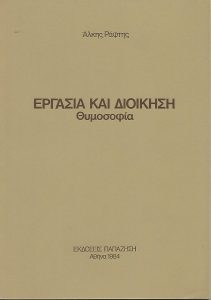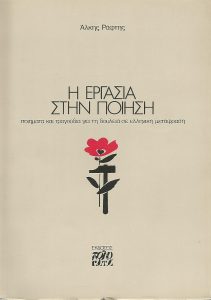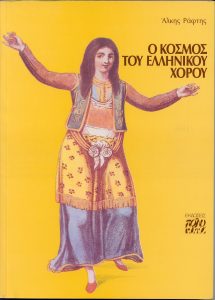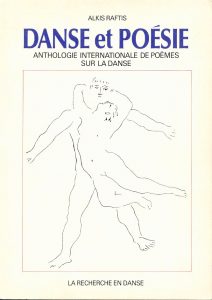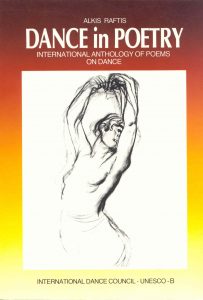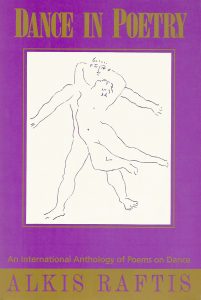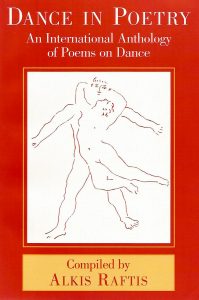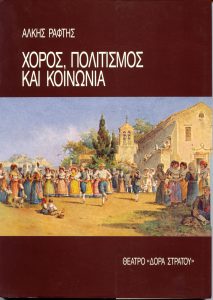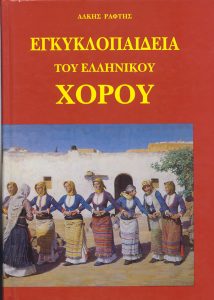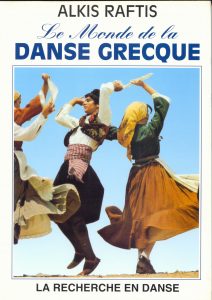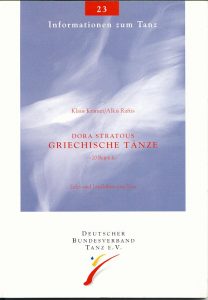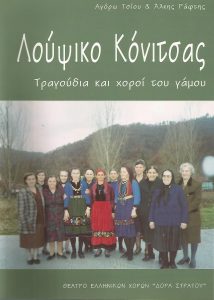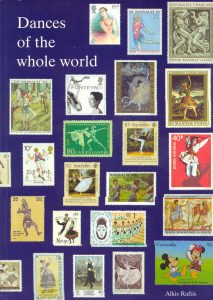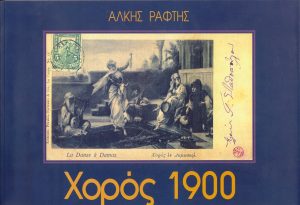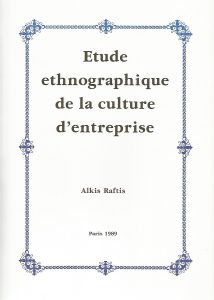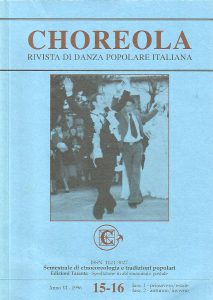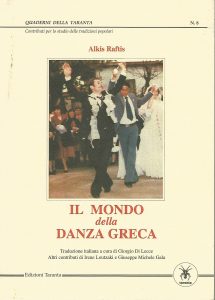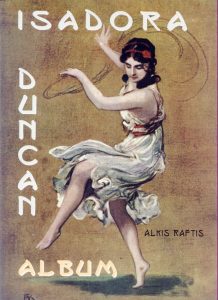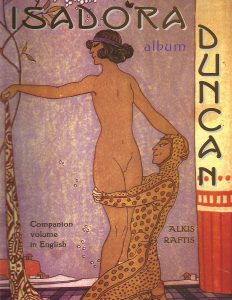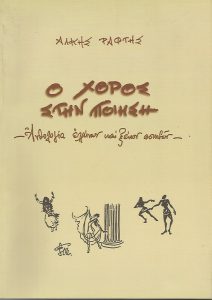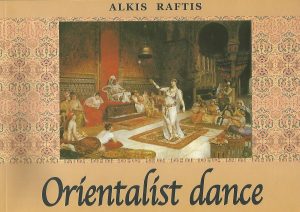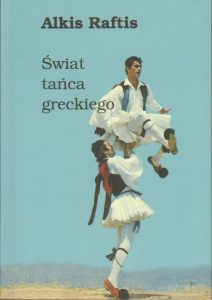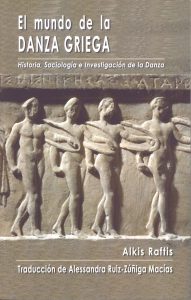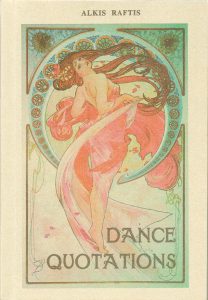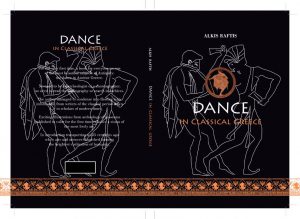Books authored
To obtain one or more of the books below please write to ExecSec@CID-world.org
Work in poetry. Poems and songs about work (originals and Greek translation).
Athens, Polytypo, 1984, 110 p.
Editor: Alkis Raftis
Publisher: Polytypo, Athens
Year of publication: 1984
110 pages 24.5 x 17.2 cm
Η εργασία στην ποίηση
Ποιήματα και τραγούδια για τη δουλειά σε ελληνική μετάφραση
Επιμελητής: Αλκης Ράφτης
Εκδότης: Πολύτυπο
Δεινοκράτους 131, Κολωνάκι, 11521 Αθήνα
Τηλ. 210 722 9237
Διάθεση: Θέατρο Ελληνικών Χορών “Δόρα Στράτου”
Σχολείου 8, Πλάκα, 10558 Αθήνα
Τηλ. 210 324 4395, φαξ 210 324 6921
www.grdance.org mail@grdance.org
Ετος έκδοσης: 1984
110 σελ. 24.5 x 17.2 εκ.
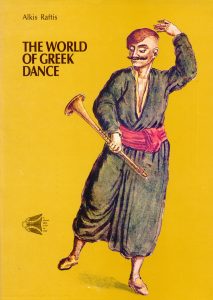 The world of Greek dance. London, Finedawn, 1987, 239 p.
The world of Greek dance. London, Finedawn, 1987, 239 p.
Preface by Prof. Gillian B Ottomley
Original edition by Fin Edawn, London, 1987
Reprinted by the Dora Stratou Dance Theatre
Scholiou 8, Plaka, GR-10558
Athens, Greece
Tel. (30)210 324 4395;
(30)210 324 6188;
fax (30)210 324 6921
www.grdance.org mail@grdance.org
First printing: 1987
239 pages (16 in color) 24 x 16.5 cm
ISBN 960-7589-009
Original hardcover edition reprinted several times as softcover.
The standard introduction to Greek dance, since 1985. The original edition in Greek has been translated to English, French, Italian, Polish. It has been used as required reading at universities, schools, workshops and classes on Greek traditional culture.
With learned introductions to folk music and musical instruments, costumes, customs, history of dance from Ancient Greece till the present, plus guidelines for research.
Includes complete directories of folk dance groups, musicians’ cafés, village festivals, institutions, books, etc.
Dance in poetry. International anthology of poems on dance. Paris, International Dance
Council CID, UNESCO, 1991, 186 p.
Reprinted by the Princeton Book Company, Princeton NJ, USA.

Preface
Dance has meant many things to many poets. Some, like Denise Levertov, see themselves in the role of the dancer:
to leap becomes, while it lasts,
heart pounding, breath hurting,
the deepest, the only joy.
Others, like William Meredith, place themselves in the audience:
/ am but one among your crowd of starers,
One of the blur of shirt-fronts and hands clapping.
There are those who admire the ballerina, as does Norma Farber:
Dancer, how do you rise?
The ground sends me.
Grace suspends me.
While Adrian Mitchell prefers an earthier genre:
….big dancers, they stamp and they stamp fast,
Trying to keep their balance on the globe.
Carl Sandburg wrote some lines for Gene Kelly to tap dance to:
Can you dance a couple of commas?
And bring it to a finish with a period?
Sacheverell Sitwell was enchanted by the Bayaderes:
They sway like young trees with wind upon their leaves
In an airy rapture……..
And Thomas Hardy imagined Grandma Jenny swooping through:
The favourite Quick-step “Speed the Plough” –
(Cross hands, cast off, and wheel)
“The Triumph”, “Sylph”, “The Row-dow-dow”,
Famed “Major Malley’s Reel”…….
The pleasures of dance and of poetry are manifold. Some dancers are happiest with the steps of classical ballet; others prefer jazz or jigs. Some poets choose to describe dancers in sonnets; others in free verse. The choices are numerous. The riches are here for the reader to enjoy.
Selma Jeanne Cohen

INTRODUCTION
This anthology, as is often the case with anthologies, grew out of a personal collection — a few poems on dance encountered by chance and put aside to read again and again. Another collecting passion, postage stamps on dance, will have to wait much longer for publication. These two collections appear to me as complementary. One can find no better way of putting side by side pictures of dance from every country in the world than through postage stamps. And there is no better way of covering the immense spectrum of aspects of dance, than by turning to the poets of the world. Much more than critics, historians or other scholars of dance, poets capture dance as a total phenomenon. No wonder, since dance is at the same time local and universal, ephemeral and eternal.
One of the most intriguing things about dance is that this art form provokes so many different emotions and ideas, and is so rich and powerful to the body as well as to the eyes. Yet, seen in a inter-ethnic and diachronic context, the dominant dance forms of today, the ones usually seen performed in television and theatres, the ones danced in schools and discotheques, seem restricted. The conception of dance within modern Western civilization is, inevitably, very limited since, in other cultures and other time periods, people danced and thought of dance differently. If one’s view of dance is to be enlarged, watching dances from other countries is necessary; furthermore, learning, practising and understanding their meaning.
So much has been written about dance being a universal language, a form of expression that readily crosses frontiers and is easily appreciated by foreign peoples. European Community planners have selected dance for priority support because among the arts dance is a non-verbal, hence convenient language for promoting understanding between nations. Most of the poerns in the following pages suggest that dance is not one language but very many, plus countless local dialects. Each indivual has his own unique dance/speech within his dance/ mother-tongue. Dance Esperantos like ballet or disco may become universal, or disappear like so many verbal and non-verbal languages throughout history.
A central preoccupation of dancers, teachers, choreographers and critics alike concerns quality: how to produce choreography with greater creativity as well as better trained dancers. This book argues, in its own way, for quantity: increased participation in dance. In a world where people gradually accustom themselves to being entertained by others, dance as a popular art faces a long-term threat. Entertainment is becoming synonymous with remaining seated, whether in the theatre, in a restaurant, or in front of the television, passively consuming a programme prepared by others. Sitting is the greatest enemy of dance. The future may bring fewer and fewer people dancing, leaving this experience to highly trained professionals. The ability to use song, music and dance in their simplest forms in order to entertain oneself is being lost.
Looking at the future, the evolution of dance is predictable. One has only to examine music – but also eating and working – to understand that they have undergone the same phases of transformation. Deritualized at first, then repressed as primary needs of the body, their practice is gradually specialized in terms of people, time and space. Next, they are sold as a spectacle and, as such, their consumption must be generalized. The final stage is stockpiling by large corporations through control of reproduction and distribution. In this process, inherent meanings are lost with mere commodities as a result. Dance is obviously becoming fetishized as merchandise, a fact dance ethnographers discover when confronted with cultures where dance remains a ritual. Given a similar perspective, poetry seems to offer a salutary refuge for the future because poetry will certainly be the last art to follow the above course.
Dance poetry is, first of all, poetry of enjoyment. Too much stress is put on creative freedom and technique when referring to theatrical dance, too much importance is given to recreation when speaking of social dance. We tend to forget that dance, as a means of “knowing” one’s partner and one’s self – in the spiritual as well as in the carnal sense – is or should be one of the most enjoyable activities known to humanity. Dance poetry celebrates that fact; and therefore is more often than not likely to arouse or titillate the reader’s appetite for dancing.
Although the specimens presented in this book inevitably reflect the anthologist’s taste, their selection was made with the reader’s pleasure in mind. Poems were not included for their historical, literary or sociological interest. Other criteria used were the broadening of the spectrum as regards dance forms, time periods and approaches to dance. Translations already published were considered, which means that some extraordinary poems in foreign languages will be found in the respective language volume or will await a subsequent volume with new translations in English.
Presenting the poems has been a problem. Aligning chronologically is the most common way used in anthologies, but then relatively few anthologies are international and even fewer are thematic. Chronological order is suitable cnly when recording events within a given frame of reference; in this case a false impression of linear evolution would be created. Arranging geographically, by continent and country of poet, seemed appropriate for local dance forms but did injustice to poets inspired by scenes of imported idioms. Finally, thematic classification (by type of dance or event) proved impossible without imposing arbitrary limits between dance forms. Alphabetical order remained, as both neutral and convenient.
I take this opportunity to express sincere gratitude to so many friends around the world who contributed poems in English or in other languages. I would like to thank Mary Pat Balkus, Professor at Radford University, without whose encouragement and help this work would have remained a few more years in manuscript form.
Alkis Raftis
Dance, culture and society (in Greek). Athens, Dora Stratou Dance Theatre, 1992.
Χορός, πολιτισμός και κοινωνία
του Αλκη Ράφτη
Εκδότης: Αθήνα, Θέατρο “Δόρα Στράτου”, www.grdance.org
Ετος έκδοσης: 1992
167 σελ.
Το βιβλίο αυτό αποτελείται από 17 αυτοτελή κείμενα, τα περισσότερα από τα οποία είχαν δημοσιευτεί προηγουμένως σε περιοδικά ή σε συνέδρια, στην Ελλλάδα ή στο εξωτερικό. Κεντρικός άξονας είναι η θεώρηση του χορού σαν κοινωνικού φαινομένου, με την παράθεση απόψεων πάνω σε ένα ευρύ πεδίο θεμάτων. Τα θέματα αυτά περιλαμβάνουν: την εξέλιξη του φολκλορικού χορού, την εκπαίδευση στον έντεχνο χορό σε ευρωπαϊκή κλίμακα, την εθνογραφική έρευνα στην Ελλλάδα, τον αρχαίο χορό, μέχρι και την ποίηση. Το σημαντικότερο ίσως από τα κείμενα αυτά είναι εκείνο όπου προτείνεται αναλυτικά μια πλήρης παιδαγωγική αντιμετώπιση του προβλήματος της αναβάθμισης του μαθήματος δημοτικού χορού. Με τίτλο “Για μια νέα γενιά δασκάλων…” δίνεται το περιεχόμενο των θεμάτων και των τεχνικών που θα πρέπει να χρησιμοποιήσει ο δάσκαλος για να γίνει το μάθημα δημοτικού χορού πλήρες και να ξεφύγει από την απλή απομίμηση χορευτικών κινήσεων.
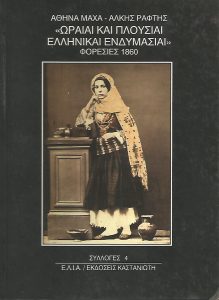 Costumes 1860 (in Greek), with Athena Makha. Athens, Kastaniotis, 1995, 111 p
Costumes 1860 (in Greek), with Athena Makha. Athens, Kastaniotis, 1995, 111 p
“Ωραίαι και πλούσιαι ελληνικαί ενδυμασίαι”
Φορεσιές 1860
Συγγραφείς: Αθηνά Μαχά και Αλκης Ράφτης
ISBN 960-03-1425-X
Εκδότης: Ελληνικό Λογοτεχνικό και Ιστορικό Αρχείο και Καστανιώτης, Σειρά Συλλογές 4
Ετος έκδοσης: 1995
111 σελ. 16.5 x 12
Εισαγωγή
Ελάχιστοι (ή μάλλον ελάχιστες) έχουν ενδιαφερθεί σοβαρά για την ιστορία της παραδοσιακής φορεσιάς στην Ελλάδα. Ενα μέσο τόσο γοητευτικό αλλά και τόσο διεισδυτικό για την κατανόηση της εξέλιξης των τοπικών κοινωνιών έμεινε ανεκμετάλλευτο. Το ιστορικό κατεστημένο πριμοδοτούσε μέχρι πρόσφατα τη μελέτη της “Ιστορίας των πολιτικών γεγονότων”, αποκλείοντας όχι μόνο τους παρακατιανούς κλάδους της “Ιστορίας της καθημερινότητας”, αλλά και πιο καθωσπρέπει προσεγγίσεις, όπως η “Ιστορία των οικονομικών συναλλαγών”.
Η Ιστορία της ελληνικής φορεσιάς – όπως και η Ιστορία της μουσικής, των χορών, των διαλέκτων και τόσων άλλων εκφράσεων του παραδοσιακού πολιτισμού – θα μπορούσε να είναι πολύ πιο πλούσια από τις αντίστοιχες άλλων ευρωπαϊκών χωρών. Αυτό δεν το λέμε από επιπόλαια εθνική αυταρέσκεια, αλλά μετά από σύγκριση με τις άλλες χώρες. Ανάλογο πλούτο είχαν και οι άλλοι λαοί της Ερώπης, απλώς όμως τον έχασαν πριν από την Ελλάδα. Η διακυβέρνηση από ξένους, η απουσία αστικής τάξης, οι μειωμένες επικοινωνίες και η φτώχεια είχαν τουλάχιστον ένα καλό: τα δικά μας χωριά και νησιά κράτησαν την αυτοτέλειά τους μέχρι πρόσφατα.
Μέσα στην περιορισμένη λοιπόν βιβλιογραφία, το έργο και η προσωπικότητα της Αγγελικής Χατζημιχάλη όχι μόνο ανοίγουν το δρόμο, αλλά και δεσπόζουν μέχρι σήμερα. Οι εργασίες των επιγόνων (Τατιάνα Γιανναρά, Κατερίνα Κορρέ, Ιωάννα Παπαντωνίου, για να αναφέρουμε αλφαβητικά τις πιο γνωστές από τις “πανελλήνιες”) εξασφάλισαν τη συνέχεια και εδραίωσαν τη μελέτη, αλλά δεν κατάφεραν να δημιουργήσουν ένα ρεύμα. Λείπει η πολλαπλασιαστική δυναμική, που θα χρειαζόταν για να καλυφθεί το αντικείμενο σε πλάτος και σε βάθος.
Οποιος ενδιαφέρεται να βρει νέα στοιχεία για την ιστορία της παραδοσιακής φορεσιάς στην Ελλάδα έχει μπροστά του την επιλογή ανάμεσα σε διάφορες ερευνητικές προσεγγίσεις. Θα αναφέρουμε τις κυριότερες:
α) Τις φορεσιές που έχουν διασωθεί σε μουσεία, σε συλλογές και στα σεντούκια των σπιτιών. Αυτές καλύπτουν τα τελευταία 100 χρόνια.
β) Τις προφορικές πληροφορίες αυτών που τις φόρεσαν. Κι αυτές αφορούν τα τελευταία 100 χρόνια.
γ) Τις φωτογραφίες – αυτές μάς πηγαίνουν μέχρι 150 χρόνια πίσω.
δ) Αλλες γραπτές πηγές, όπως προικοσύμφωνα, εφημερίδες, λογοτεχνικά και κάθε είδους κείμενα στα ελληνικά – πάλι για τα τελευταία 150 χρόνια.
ε) Τα χαρακτικά, τους ζωγραφικούς πίνακες και τις περιγραφές ξένων περιηγητών του 18ου αλλά κυρίως του 19ου αιώνα. Ας ορίσουμε σχηματικά την περίοδο που καλύπτουν στα τελευταία 200 χρόνια.
Για το διάστημα από τα τέλη του 18ου αιώνα μέχρι την αρχαιότητα υπάρχουν βέβαια άλλες πηγές, αλλά δεν αφορούν πλέον το ίδιο αντικείμενο. Το ίδιο ισχύει και για τη μελέτη της φορεσιάς γειτονικών λαών που επηρρέασαν τους Ελληνες. Πρόκειται για την “προϊστορία” της παραδοσιακής φορεσιάς.
Το βιβλίο αυτό έχει σκοπό να δώσει το έναυσμα για την παρουσίαση των αμέτρητων φορεσιών που είναι αποτυπωμένες στις παλιές φωτογραφίες. Οταν οι πληροφορίες που μπορούν να μας δώσουν διασταυρωθούν με τις άλλες πηγές που αριθμήσαμε παραπάνω, τότε η Ιστορία της ελληνικής φορεσιάς θα έχει ολοκληρωθεί. Οπωσδήποτε, η περισυλλογή των προφορικών πληροφοριών με επιτόπια έρευνα είναι η σπουδαιότερη μέθοδος – και η πιο επείγουσα.
Μιλήσαμε για έναυσμα και για παρουσίαση, γιατί δεν επιχειρούμε μια ενδυματολογική μελέτη δημοσιεύοντας αυτή τη μικρή συλλογή. Θελήσαμε μόνο να ευαισθητοποιήσουμε το ευρύ κοινό και να προσελκύσουμε όσο γίνεται περισσότερους νέους ανθρώπους στον γοητευτικό και απέραντο κόσμο της φορεσιάς.
Οταν ανακαλύψαμε ότι ανάμεσα στους θησαυρούς που έχει συγκεντρώσει στις συλλογές του το Ε.Λ.Ι.Α. υπάρχουν αυτές οι φωτογραφίες, δεν μπορέσαμε να αντισταθούμε στον πειρασμό να τις δημοσιεύσουμε με λίγα σχόλια.
Ολες οι φωτογραφίες της συλλογής έχουν διαστάσεις 9,5 χ 6 εκ. και είναι κολλημένες σε σκληρό χαρτόνι. Εδώ παρουσιάζονται σε μεγέθυνση. Ανήκουν στην κατηγορία των cartedevisite. Αυτό δεν σημαίναι ότι χρησίμευαν για επισκεπτήρια αλλά ότι είχαν μέγεθος επισκεπτηρίου. Ο τύπος αυτός καθιερώθηκε το 1854 στη Γαλλία από τον André Disderi και επέτρεπε για πρώτη φορά την ταυτόχρονη παραγωγή 25 ή περισσοτέρων αντιτύπων με μικρό κόστος.
Από το βιβλίο του Αλκη Ξανθάκη “Ιστορία της ελληνικής φωτογραφίας” μαθαίνουμε ότι στην Αθήνα οι πρώτες φωτογραφίες τύπου cartedevisite τυπώθηκαν το 1860 από τον Αθανάσιο Κάλφα και είχαν αμέσως μεγάλη διάδοση. Ο Κάλφας διατηρούσε φωτογραφείο μαζί με τον ζωγράφο Νίκο Φαρμακίδη μέσα στο ξενοδοχείο “Απόλλων” στην οδο Ερμού. Αλλοι φωτογράφοι της εποχής που αναφέρονται είναι ο Κάρολος Σχήφφερ, ο Πέτρος Μωραϊτης, ο Φίλιππος Μαργαρίτης και ο Ξενοφών Βάθης. Ο κάθε Ελληνας μπορούσε πλέον να κάνει συλλογή από φωτογραφίες διασημοτήτων, με πρώτες των βασιλέων Οθωνα και Αμαλίας.
Αξίζει σ’αυτό το σημείο να υπενθυμίσουμε ότι οι φωτογραφίες της εποχής εκείνης δεν είχαν καθόλου σαν σκοπό τους να αποτυπώσουν μια κάποια “τυπική” μορφή της τότε φορεσιάς. Οι φωτογραφιζόμενοι φορούσαν απλώς τα ρούχα με τα οποία καμάρωναν. Πρόκειται για ιδιαίτερα εύπορα άτομα που, όταν δεν είχαν αποφασίσει να ασπαστούν την ευρωπαϊκή μόδα, διατηρούσαν μεν την φορεσιά του τόπου τους αλλά σε μια εξεζητημένη μορφή της. Οι χειρόγραφες λεζάντες τους είναι κι αυτές αμφισβητίσιμες, γιατί είναι πιθανό να γράφτηκαν από υστερώτερους συλλέκτες.
Αλλη επιφύλαξη αφορά τους χρωματισμούς. Οι φωτογραφίες ήταν βέβαια μονόχρωμες (η έγχρωμη φωτογραφία επεκράτησε περίπου εκατό χρόνια αργότερα), αλλά οι φωτογράφοι συνήθιζαν να τις χρωματίζουν με σινική μελάνη, με κάποια πρόσθετη αμοιβή. Το επάγγελμα του φωτογράφου ήταν τότε συγγενές με του ζωγράφου, πολλοί άλλωστε δήλωναν στις διαφημίσεις τους “φωτογράφος και ζωγράφος”. Δεν είναι λοιπόν καθόλου βέβαιο ότι τις επιχρωμάτιζαν σωστά.
Τελειώνοντας, θα θέλαμε να ευχαριστήσουμε τον Μάνο Χαριτάτο που έθεσε στη διάθεσή μας τις φωτογραφίες και τα αρχεία του Ε.Λ.Ι.Α., τον Γιάννη Μυλωνά για τις πληροφορίες του σχετικά με τις στρατιωτικές στολές και την Αδαμαντία Αγγελή για τη δακτυλογράφηση των κειμένων.
Αθηνά Μαχά & Αλκης Ράφτης
Loupsiko. Wedding dances and songs (in Greek), with Agoro Tsiou.
Athens, Greek Dances Theater, 1997, 143 p. and CD.
Loupsiko, Konitsa
Wedding songs and dances (in Greek)
by Agoro Tsiou and Alkis Raftis
Publisher: Dora Stratou Dance Theatre, Athens, www.grdance.org
143 pages 24 x 17 εκ. + CD
ISBN 960-7204-14-X

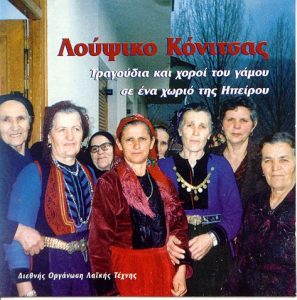
Λούψικο Κόνιτσας
Τραγούδια και χοροί του γάμου
Συγγραφείς: Αγόρω Τσίου και Αλκης Ράφτης
Εκδότης: Θέατρο Ελληνικών Χορών “Δόρα Στράτου”
Σχολείου 8, Πλάκα, 10558 Αθήνα
Τηλ. 210 324 4395, φαξ 210 324 6921
143 σελ. 24 x 17 εκ. + CD
ISBN 960-7204-14-X
Dances of the whole world. A complete catalogue of stamps.
Athens, Greek Dances Theater, 1998, 77+16 p.
Bronze medal, Kifissia Philatelic Exhibition, Athens, Greece,1999
Bronze medal, World Philatelic Exhibition, Nürnberg, Germany, 1999
Bronze medal, Brno 2000 National Stamp Exhibition, CzechRepublic, 2000
Silver bronze medal, 5th National Philatelic Literature Exhibition, Ottawa, 2000
Silver bronze medal, Chicagopex 2000 Exhibition, Rosemont, Illinois, 2000
Silver bronze medal, Cyprus-Europhilex 2002, Cyprus, 2002

Dances of the whole world
on postage stamps. A complete catalogue
Author: Prof. Dr. Alkis Raftis
Preface: Prof. Dr. Roderyk Lange
Publisher: Dora Stratou Dance Theater
Scholiou 8, Plaka, GR-10558 Athens, Greece
tel. (30)210 324 4395;
fax 210 324 6921
Under the auspices of the International Dance Council CID, UNESCO
Publication date: 1998
Pages 77+16 colour
ISBN 960-7204-15-8
Price: 14 euros
– A complete catalogue of the 3,000 postage stamps on dance
– 93 pages, format A4 (30.5 x 22.5 cm), 16 pages illustrated in color
– Catalogue numbers: Scott, Stanley Gibbons, Michel, Yvert et Tellier
– Stamps arranged by country, year of issue, denomination
– Short description of the dance scene, plus philatelic information
– All the 267 countries, past and present, on the globe
– All genders of dance, from prehistoric to ancient to ballet, to traditional to modern to disco
– Indispensable for collectors and dance historians
– Authored and prefaced by two of the world’s most respected dance scholars.
Cover T000140

Bronze medal, Kifissia Philatelic Exhibition, Athens, Greece,1999

Bronze medal, World Philatelic Exhibition, Nürnberg, Germany, 1999


Bronze medal, Brno 2000 National Stamp Exhibition, CzechRepublic, 2000

Silver bronze medal, 5th National Philatelic Literature Exhibition, Ottawa, 2000
Silver bronze medal, Chicagopex 2000 Exhibition, Rosemont, Illinois, 2000


Silver bronze medal, Cyprus-Europhilex 2002, Cyprus, 2002
Preface
It is well known that iconography plays a vital role in tracing dance activities in the past. When there are no descriptions of the dance progression available, when no music survives the pictorial representations of dance scenes supply us at least with a visual record, proving, that certain dance activities existed. Even if a picture on its own does not convey the movement, one may deduce from it some information on the type and style of dancing during a certain period. For this reason iconography is a much respected source material in dance research.
Alkis Raftis has collected postal stamps with dance representations for a long time. This domain was until now quite neglected. It represents, though, an important document of the appreciation of dance in our time, and is an indication of the recognition of its growing status.
The author has drawn together extensive material in this publication, and catalogued it. For this labor of love future generations of dance researchers will certainly be grateful. Roderyk Lange

Introduction
The present catalogue represents the first attempt to approach dance in a truly global perspective. In issuing postage stamps, every country strives to project its image inland and abroad. Accordingly, for every single country one can see now the vision it has of its own dance.
No book exists dealing with dance in all the countries of the world. “History of dance” books number by the thousands, but they mostly deal with ballet and modern dance. Their focus is always on theatrical dance of the European tradition, with a couple of odd chapters on other dance forms. When treating non-theatrical or non-European dances, they cannot help to see them in a superficial or ethnocentric perspective. On the other hand, there are many books dealing with dance in one country or one small region, and so many more could be written before local dance idioms disappear under the pressure of television-diffused culture.
Dance teachers and dance group leaders know very well that, among the persons who take up dance in their teens, in infinite fraction remains when in their twenties. From then on, they very rarely practice dance, if at all. Some become occasional spectators of dance performances, even less keep in touch by reading dance magazines or books.
Collecting dance stamps can keep a great number of young – and less young – people abreast with the art, bring them in contact with other enthusiasts around the world, while offering an encyclopedic knowledge of the subject. This catalogue is addressed primarily to dance teachers who, if not ready to adopt the hobby themselves, should drop the idea to their students.
Thematic stamp collecting is a hobby for dozens of millions of persons around the globe but, among the hundreds of themes selected, dance is a rarity. One wonders why, especially since so many young persons attend dance schools or take part in folk dance groups, not to mention those frequenting dance halls or discothèques. Collecting dance stamps, besides the general benefits of stamp collecting, broadens one’s understanding of dance and enhances the pleasure of practicing or watching dance.
In compiling this catalogue, several questions have arisen, involving a number of choices as to which stamps should be included.
– Is it dance? In a great number of scenes it is not clear whether the persons depicted are dancing or simply adopting a dance-like posture. We have included these stamps, guided by the context of the scene, and noted our doubt by a question mark.
– What is dance? Scholars have struggled for ages with definitions of dance. It is still not clear how to classify borderline cases, like ice-dancing (more correctly called figure-skating), rhythmic gymnastics or water-dancing. Some people even claim animals dance. Definitely, not every rhythmical movement is dance, even when it is accompanied by music. Otherwise, a military parade would be dance. The definition we propose is Dance is organized expressive movement. When the esthetic expression through body movement as such is dominant, then it is not dance. We believe that when the primary object is physical exercise, it should be classified under “sports”, even when it involves graceful movement with music. Not to disappoint some collectors, we have included a number of such stamps.
– What about dance-related objects? The most common case is dance masks, but also ballet shoes, tambourines, castanets and other objets used by dancers and clearly implying dance. When they are depicted outside a dance scene, we have included them only when the context makes it clear that they are used to point specifically to dance (for example as symbols of a dance festival).
– Should dance-music be included? The answer was easily negative – dance music is not dance. Stamps with composers, musical instruments, opera houses, scores etc. belong to the sphere of music stamp collecting, enjoying a great number of collectors and abundant literature.
Fortunately, most of the stamps compiled here denote dance clearly. To make things even simpler for dance stamp collectors, we have used this rule of thumb: When in doubt, we include a stamp if at least one of the four catalogues consulted mentions dance in its description.
This catalogue is updated constantly to include new issues of stamps and revise or add catalogue numbers. An edition in CD-ROM form is under preparation. It will include the contents of this catalogue, plus color illustrations of more than 1,000 stamps, plus extensive notes of the dances and dancers mentioned.
The data has been arranged in fields:
COUNTRY – The country issuing the stamp
YEAR – Year of issue
DENOMINATION – Face value of the stamp
DESCRIPTION – Short description of the dance scene
SCOTT – Scott catalogue number
GIBBONS – Stanley Gibbons catalogue number
MICHEL – Michel catalogue number
YVERT – Yvert et Tellier catalogue number
NOTES – Additional information, mainly philatelic. This field is used to give distinctive signs of the stamp, such as color, air mail, overprinting, souvenir sheets etc., to facilitate recognition, especially in case of similar issues.
Dance 1900
Greek turn of the century postcards portraying dance
(in Greek)
Author: Alkis Raftis
Publisher: Dora Stratou Dance Theater
Scholiou 8, Plaka, GR-10558 Athens, Greece
tel. (30)210 324 4395;
(30) 210 324 6188;
fax 210 324 6921
Publication date: 1999
237 pages in color 19.5 x 28.5 cm.
ISBN 960-7118-13-8 (9607118138)
157 postcards dating around 1900, depicted at enlarged size, with detailed historical comments in Greek.
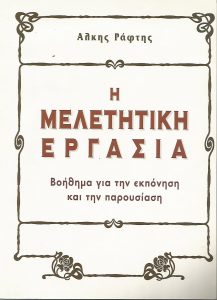 The scholarly work (in Greek). Athens, Way of Life Publications, 2000, 104 p.
The scholarly work (in Greek). Athens, Way of Life Publications, 2000, 104 p.
Author: Alkis Raftis
Publisher: Way of Life Publications, Athens
Distributor: Dora Stratou Dance Theater
Scholiou 8, Plaka, GR-10558
Athens, Greece
tel. +30 210 324 4395;
+30 210 324 6188;
fax +30 210 324 6921
Year of publication: 2000
104 pages 24 x 17 cm
ISBN 960-7118-19-7 ( 9607118197 )

Η μελετητική εργασία
Βοήθημα για την εκπόνηση
και την παρουσίαση
Συγγραφέας: Αλκης Ράφτης
Εκδότης: Εκδόσεις “Τρόπος Ζωής”
Διάθεση: Θέατρο Ελληνικών Χορών “Δόρα Στράτου”
Σχολείου 8, Πλάκα, 10558 Αθήνα
Τηλ. 210 324 4395, φαξ 210 324 6921
www.grdance.org mail@grdance.org
Ετος έκδοσης: 2000
104 σελ. 24 x17 εκ.
ISBN 960-7118-19-7 ( 9607118197 )
Isadora Duncan and the artists (in Greek with English supplement). Athens, Way of Life Publications & Dora Stratou Dance Theatre, 2003, 222+79 p.
Publisher: Dora Stratou Dance Theatre
Scholiou 8, Plaka, GR-10558 Athens, Greece
Tel. +30 210 324 4395, fax +30 210 324 6921
www.grdance.org mail@grdance.org
Publication date: 2004
222+79 pages 29.5 x 22.5 cm
ISBN 960-7118-90-1 (Main volume in Greek)
ISBN 960-7118-90-1 (companion volume in English)
Price: 35 euros (the two volumes)
10 euros (as eBook)
Works or texts by 106 artists of her time. Original research in archives during 10 years brought to light many works of art as well as passages from rare books describing Isadora Duncan’s unique dance. In the complete absence of films, this album is the best possible view of her dancing. Full colour, large format reproductions of paintings, sculptures, sketches (no photographs) by world-acclaimed artists. Passages from famous writers translated to English and Greek from several languages, by the one of the world’s most prolific writers on dance.

INTRODUCTION
In 1903 Isadora Duncan came with her brother Raymond to Athens, where she had dreamed of settling and founding her school, the school from which would spring the first dancers of Modern Dance, inspired by the dance of Ancient Greece. They started to build a house, which never became the school that Isadora had dreamt of.
Today, however, a hundred years later, this memory-laden house, a monument in the worldwide history of dance, has been completed by the Municipality of Vyronas and is already operating as the “Centre of the Study of Dance”, open to all the current developments in dance, and we all hope that it will be dedicated to the cultivation of a modern dance that will be as close as it can be to Ancient Hellenism.
This provides the opportunity to present today something that has been missing from international bibliography: an anthology of the works of the important artists who knew Isadora Duncan and immortalised her.
Alkis Raftis

The Duncan phenomenon
The bibliography on Isadora Duncan is enormous, but the writing is almost entirely descriptive. It consists either of biographies recounting the events of her life, or of reviews and impressions of her performances, which inevitably have a large dose of subjectivity. My own position is that of sociologist and historian.
I see Isadora Duncan more as a social phenomenon. I am interested in finding out:
– What reasons led to her emergence and the emergence of other similar dancers at that time, even though these may not have made history?
– What factors shaped her thinking and generally her personality?
– How can society’s reception of her be explained? In particular: who formed her public, or rather, who formed her publics, since they consisted of specific and disparate groups? What did each of these groups find in Duncan?
– What was Duncan’s “message”? What was the space she came to fill in the society of that time? How did she pass her message on to her public, and how did her public’s messages reach her?
Origin and development
– Middle-class family, artistically educated parents.
– She grew up in deprived circumstances, without a father.
– She left school before she had completed her elementary education.
– She taught herself French and German.
– She taught herself dance and music.
– She studied philosophy, theatre.
– She wore Greek chitons at a time when women usually wore corsets and several petticoats.
Dance
– She danced barefoot and half-naked, when serious stage dancing was synonymous with “tutu” and “pointes”.
– She was the first to use the musical works of great composers that had not been written for dancing.
– She appeared on stage alone; it was only later that her young pupils sometimes accompanied her.
– She used the simplest of costumes, with no scenery.
– She did not perform choreographies; she improvised, or rather gave a spontaneous interpretation of the music.
– She attempted to dance to Byzantine music, a practice so far ahead of her time that no one dared to follow it for a whole century afterwards.
– In spite of the sensual dimension of her dance, the most serious critics insisted that it was not provocative.
– Today’s choreographers have begun to take movements and gestures from everyday life. Duncan was ahead of them in this by about 80 years.
Her impact on society
What were the social groups that constituted her public?
– Royalty and heads of state
– Artists
– Intellectuals and students
– The upper middle class (in Europe and America)
– Workers and farmers (in the Soviet Union)
A list of leaders of state who attended her performances:
– President Roosevelt of the USA,
– The King of Bulgaria, with whom she was said to have had an affair,
– King George I of Greece, who, when he heard of her triumphant performance at the Municipal Theatre in 1903, asked her to perform in the Royal Theatre, where he went with his entire family,
– Prime Minister Eleftherios Venizelos, who invited her to settle in Greece for the second time in 1920.
– The Empress of Germany Augusta Victoria, who saw one of her performances in Berlin and criticized her barefoot pupils,
– Vladimir Ilyich Lenin, leader of the Soviet Union, who showed more enthusiasm than all the others.
Morality
Sceptics will say that such enormous success could be due to the fact that Duncan offered a very daring spectacle, at the same time covering it with the alibi of avant-garde art. Men in the audience could, without pangs of conscience, feast their eyes on a statuesque body, whose nakedness was only minimally hidden by her classic chitons and expressive movements.
They should recognise however that Isadora Duncan’s success led to the appearance of many other dancers with equivalent physical advantages, more sensuous dancing and often more undisguised nudity. Ruth Saint Denis in America, Maud Allan in England, Adorée Vilani in France were among the best known. For many others, dance was nothing more than an excuse for moving their bodies provocatively, though few of them had more to show than their curves.
There was no lack of competition in this field, and Duncan would not have stood out if her body were the main attraction for audiences. Besides, she herself often refused to collaborate with impresarios who offered her tempting fees, if she suspected that they meant to present her as the “half-naked dancer”.
The reader might think that I sympathise with the established view that regards sensual dance as inferior. For instance, dancers of all other kinds (theatrical, folk, ballroom) unanimously look down at dancers of “Anatolian dance” (oriental, belly dance, dance of the seven veils, cabaret etc.). This is an unfair and superficial view that should somewhere else be objectively refuted. Sensual dance, in all its nuances, is equally serious, just as artistic and undoubtedly beautiful; it is socially useful, and historically older than other kinds of dance.
Women’s rights
Revolutions – like all social phenomena – are a combination of two factors. On one hand the ripeness of circumstances, development to the point where radical change is necessary and feasible. On the other hand, the emergence of one or more people who sense the need for change, personify it and fight for it until they bring it about. We should see Duncan’s revolution in this way.
Isadora declared unequivocally that she supported the rights that should belong to every woman:
– To be married or not.
– To make love to whatever man she wished.
– To have children or not.
– To look after her children herself or not.
– To travel on her own.
– To express her political opinions.
Anyone with a knowledge of the conditions prevailing the start of the twentieth century will realise how explosive such opinions were then.
Politics
In spite of the fact that she was not interested in politics, Isadora had the instinct and the daring to follow whatever was most progressive in the ideas of her time. We should not be prejudiced by the picture we have today of the those political currents; the important thing is that she espoused the most avant-garde ideas at that time. It took a sharp instinct to choose them and particular courage to follow them.
In Greece, for example, she sided with Eleftherios Venezelos, who was then in conflict with the King. In Russia, at a time when almost all the Russian dancers and choreographers were leaving for Europe and America, she alone moved against the current: she sided with the Bolsheviks from the beginning and worked hard to help the Revolution with her dance. She supported her views not only with words, as usually happens in politics, but with harsh personal sacrifices: when Anna Pavlova and Vaslav Nijinsky were living in the most luxurious hotels in Nice and Paris, she was touring the remotest areas of Soviet Russia in conditions of indescribable poverty.
Greek spirit
Isadora and her brother Raymond were not the first people to worship Greece. A hundred years before them, many eminent foreigners had fallen under the spell of the classical beauty of ancient Greece, and had remained faithful to it in spite of the bitterness the actual Greece soaked them with. Once again the Duncans went further than the others: they translated the Ancient World into everyday action, they tried it out on their bodies. They wore chitons and sandals that Raymond had made, they danced trying to bring to life the scenes on the ancient vases.
Most important of all, they actually came to live in Greece. We should not forget that many of the Greek-worshippers before them, starting with Winkelman, had never visited Greece even as sightseers. The Duncans came for the first time in 1903. It was Raymond who played the main part in this, returning at every opportunity for sixty years.
On two other occasions Isadora attempted to settle in the country, even though this would have amounted to sure professional suicide. What could an international personality expect from the Greece of 1903? A faraway country, small, poor, destroyed by wars and strife, where there were neither dance schools, nor professional dancers, nor even the conditions for the development of theatrical dance. Sikelianos’ efforts themselves twenty years later failed because Greece was too backward to accept them.
Ecology
Nowadays, eating natural foods and generally living in harmony and contact with nature is something that is supported by ecologists, and it seems reasonable enough. One hundred whole years have passed however, since the days when Raymond Duncan recommended it. Only ten years ago, such ideas were still daring and generally unknown to many people. Imagine how avant-garde such ideas were then. The ecological movement was ninety years behind Raymond Duncan, and still has not caught up with him. For Duncan turned ecology into everyday action: he wove his own clothes on the loom, and he himself made the sandals that he wore, his furniture and his implements. Today’s “green” organisations would not dare to advise the public to follow him.
And as if this was not enough, the Duncans went even further. They discovered that there was an ecological kind of music, the “natural scales”, which had passed from ancient music into Byzantine hymns. Today’s ecologists have not yet suspected this, that there exists a kind of “ecology of music”. Isadora dared to dance to this music, and Raymond taught it for decades, but their efforts came to nothing because they were so far ahead of their time.
I mention Isadora more than Raymond because she is the one who became famous. Brother and sister were always close and one influenced the other, which is why we can talk of the “Duncan phenomenon” from a historical point of view. Raymond won no acclaim because he moved in duller spheres and was more down-to-earth. He too, however, was just as pioneering in his own way.
Suffice it to say that he engaged successfully in dramatic art, poetry, painting, weaving, sculpture, singing, sandal-making, building, wood-carving, as well as European and Byzantine music. He taught all these things – and perhaps others that I have missed – first in Athens and later, until his death in 1967, at the “Academy” he founded in Paris, occasionally giving shows in New York. It would be an omission not to mention (as a hint to the present situation in Kossovo) the fact that after the Greek army entered Albania in 1914, he went to Saranda and helped the locals cope with the misery left by the war. Conditions were so bad there that his wife Penelope, sister of Angelos Sikelianos, became ill and eventually died. It is a great injustice that this great philhellene has not been honoured for his wide-ranging service to Greece.
Dance
There is little need to speak of the crucial importance that the emergence of Duncan had on the development of dance. It is a platitude to say that she is one of the greatest dancers, if only because there is no book on dance history that does not devote several pages to her. Quite a few people would dispute, however, that she was the greatest figure of all. It is worth noting, though, who such people might be.
They are those who stick with whatever technique they were taught and feel the need to defend it. Those who do not have the wide culture or the discriminating sensitivity to see beyond the narrow frontiers of their kind of dance (academic, modern, jazz, character etc.) and to appreciate dance as an art that encompasses all the planet and all ages. In this huge polymorphism, every individual’s technique appears insignificant, while Duncan’s “non-technique” seems great.
I believe that if dance à la Duncan did not spread as much as other schools or fashions it is due to the fact that it was vehicle for an anti-commercial outlook. It was not a “product” suitably “packaged” so that it would “sell”. It did not have “secrets”; it did not have preordained exercises, nor a framework that a dance teacher could declare to possess in order to attract pupils. Duncan’s dancing was based mainly on a deep understanding of dance, of the human body and its expressiveness, of a sense of theatre. Still more, Duncan’s dancing was the outcome of a worldview, which is a feature no one could claim for some of the more usual techniques.
Some dance historians throw the blame on Duncan’s pupils, asserting that they were not equal to continuing her work. Others use the fact that the “Duncan school” has comparatively few representatives today as a criterion to show that her worth was limited.
I will be in the minority in asserting that Duncan’s contribution was not only enormous but also unique in the world history of dance. We should not confuse her with the other dancers, Nijinsky, Pavlova or Saint-Denis: Duncan was something more than a great dancer. We should distinguish her from the great choreographers, Fokine, Balanchine and Graham: Duncan created something more than choreographies.
Isadora Duncan was the greatest because she opened the way for the others we mentioned and for all the other dancers and choreographers. They all came after her, they were influenced by her, and they recognised it more or less. Before her there was only a sterile academic dance, which needed her contribution in order to become fertile again.
She was a complete dancer. The others dedicated their life to dance: she dedicated her dance to life. The others said many things with their dance, but outside their dance they had nothing to say. She, however, brought the revolution to dance and to every other aspect of her life. She set dance on its feet and brought it face to face with the other arts. She stood as an equal with artists and politicians, with philosophers and scholars, having her own point of view, the point of view of a dancer about life and art.
In the pages that follow we try to give a picture of the feeling that Isadora’s dance left on the artists of her times.
Alkis Raftis

ISADORA DUNCAN – HER LIFE
1877
Angela Isadora Duncan was born in San Francisco on 26th May 1877. Her mother was Mary Isadora (Dora) Grey, the daughter of Thomas Grey, who had fought in the Civil War, and had risen to the rank of Colonel. After the War he was appointed a harbour official in San Francisco and finally became a member of the California House of Representatives. Isadora’s father was Joseph Charles Duncan, a businessman who was thirty years older than her mother. They had four children: Mary Elizabeth, Augustin, Raymond and Isadora. Isadora was just five months old when her father’s bank went bankrupt and he himself disappeared to avoid the consequences. From then on, Mary Duncan started to work in order to support her children, while they grew up in deprived circumstances, unsupervised, in a spirit of independence and with a sense of responsibility. In their family environment they learnt to love the arts, playing drama and music in their home.
1887
Isadora left school when she was about ten years old and started to give ballroom dancing lessons to the children of the neighbourhood, helped by her brothers and sister and with her mother at the piano. From then on, she used to read a great deal, a habit she kept up for the rest of her life. In her dancing she must have been much influenced by the ideas of François Delsarte, which were then finding fertile soil in America. Delsarte was the first who studied gestures and put forward a system based on natural, expressive movements.
1895
She went with her mother to Chicago, where she danced for the first time in public, performing Mendelssohn’s “Spring Song”. The theatrical entrepreneur Augustin Daly engaged her in his company in New York, where she took several dance lessons with the well-known ballerina Maria Bonfanti.
1896
She started giving individual performances in theatres and at gatherings in private homes, with the music of Ethelbert Nevin, who himself played the piano. The public were amazed that she dared to dance with bare hands and feet, as well as by her unprecedented free and expressive dance.
1897
She took part in performances of Daly’s company in London, where she had dancing lessons with Katti Lanner. She continued to give dancing lessons to children.
1899
The hotel where the Duncan family were staying caught fire while Isadora and her sister Elizabeth were giving a lesson. By keeping calm they managed to get all their young pupils out, but all their possessions were burnt. She left with her brothers and sisters for London, where she danced at gatherings of art lovers, coming to know various scholars and artists. She went to theatre performances, and studied the Greek sculptures in the British Museum.
1900
She went with her mother to Paris, where her brother Raymond was already staying. With him she studied the representations of ancient dance on Greek vases and in sculptures of the Louvre. She was impressed by the Universal Exposition, especially by the works of Rodin and the performances of Japanese dance. She danced in salons and gave lessons.
1901
She gave recitals in Monte Carlo and in London, with dances inspired by Ancient Greece, Renaissance Italy and contemporary music. The critics gave her a favourable reception. The dancer Loïe Fuller included her in her troupe travelling to Berlin, Leipzig, Munich and Vienna.
1902
In Budapest Isadora gave solo performances in the theatre Urania, dancing to music by Strauss and Liszt, with great success. It was at this time that she first made love, with the young actor Oscar Beregi. Afterwards she parted from Beregi and went to Vienna, where she recovered from a short illness. She danced very successfully in Munich. Her public, mainly young people and students, adored her. After every performance they dragged her carriage to her hotel, where they sang under her windows.
1903
She danced in Berlin and gave her famous lecture on the subject “The dance of the future”, in which she presented her ideas. The text circulated widely in various languages, and is still considered the manifesto of modern dance as well as of the women’s liberation. She returned to Paris, where she gave several less successful performances at the Sarah Bernhardt Theatre. The critics found the dancing charming and interesting, but not serious enough. She was offered a new tour of Germany, but refused.
1903
Her brother Raymond organised a family trip to Greece. From Brindisi they arrived in the island of Lefkada, and from there they went on by caique to Kravasara (today called Amphilochia) where they disembarked and knelt and kissed Greek soil. They called at Agrinio, Missolonghi and Patras, and arrived in Athens. There they bought a stretch of land on the hill of Kopanas (today in the Municipality of Vyronas), which was then open grazing land, and started to build a house, using plans inspired by the Palace of Agamemnon. They wore chitons and sandals and studied ancient Greek art intensively, under the guidance of the archaeologist and scholar Alexander Philadelpheus. They discovered that the ancient Greek music had survived in Byzantine chants, and formed a choir under the direction of Constantine Psachos. Isadora danced in the Municipal Theatre on the 28th of November, where the public, mainly students, gave her a standing ovation. By royal invitation, she gave a second performance on the 11th of December, this time in the Royal Theatre before King George I and all his family, the French writer Pierre Loti and the cream of Athens society. She left for a period in Europe with her choir under the direction of Panaghiotis Tzaaneas.
1904
Her performances were intended to lead to the revival of ancient tragedy, but the public wanted something lighter than Aeschylus’s “The Suppliants”. In vain Isadora gave long talks before each performance, introducing the subject. After performances in Vienna, Munich and Berlin, she disbanded the Greek choir. Her impresario urged her to do a tour of Germany where success was assured, but she preferred to settle down in Berlin, where she was learning German and studying philosophy, especially Nietzsche. Cosima Wagner suggested that she should dance at the Wagner Festival in Bayreuth. She danced the lead in “Tannhäuser”, accompanied by ballet dancers. Public response was disappointing, but the critics found it an interesting experience. She did a tour in Germany. In Berlin she fell in love with the stage designer and theatre innovator Edward Gordon Craig, son of the great English actress Ellen Terry. It was this year that she went to Russia for the first time and gave a performance in Saint Petersburg with music entirely by Chopin. The public and the critics gave her an enthusiastic reception.
1905
She returned to Russia and danced in Moscow. She watched ballet performances and met the great dancers Anna Pavlova and Mathilda Kschessinska, the stage and costume designer Bakst, the producer Diaghilev and the choreographers Marius Petipa and Michail Fokine. Fokine admired her and found her an inspiration for his future choreographies. She danced in Kiev and Moscow, where the public, mostly students, artists and intellectuals, received her with enthusiasm. She returned to Berlin and founded a school with her sister Elizabeth. Twenty young girls were selected from many candidates to be boarders, and, in addition to the usual programme of school subjects, attended lessons in free dance, music, singing, elocution, painting and pottery. The Empress Augusta Victoria attended one performance by Isadora and her pupils, but found the sight of their bare feet unacceptable, out of keeping with the strict morals of the age.
1906
A period with Craig in Germany, Belgium and Holland. She visited the Scandinavian countries. She danced with success in Warsaw and in other Polish cities. It was in Holland in September that she gave birth to her first child, Deirdre. She continued in Holland, until she finally collapsed with exhaustion. She went to Florence, where Craig was doing the sets for “Rosmersholm” with the famous Italian actress Eleonora Duse in the lead.
1907
Craig had tired of his stormy life with her and left her so that he could work in the theatre without distraction. After a period of recuperation in Nice, Isadora danced in Holland, Sweden, Germany and Switzerland. The continued successes brought her plenty of money, but her expenses were always huge: she stayed in the most expensive hotels and was supporting Craig, the baby and its governess, her mother, her sister and the school and its pupils. At the same time, she always received less than was due to her, because of her inability to handle financial matters. She continued her tour: Holland, Warsaw, Munich, Russia. In Moscow she became close friends with Constantin Stanislavsky.
1908
She gave several performances at the Gaieté-Lyrique theatre in Paris, but without success, since public attention was focussed on the concerts of Russian music that Sergei Diaghilev was organising then. She started a tour in the United States, but seeing the indifference of the public, she cut it short and returned to New York. There she met Walter Damrosch, the conductor of the New York Symphony Orchestra, and gave a recital with the 80-member orchestra at the Metropolitan Opera House. The programme included excerpts from Gluck’s “Iphighenia in Aulis”, Beethoven’s Seventh Symphony, and Wagner’s “Tannhäuser”. It was a great success, which was continued at performances in other cities.
1909
Instead of exploiting her triumph in America, she returned to Paris, where her pupils now were. She again gave performances at the Gaité-Lyrique theatre, despite the fact that Diaghilev’s Ballets Russes were appearing triumphantly in the same season and were monopolising the attention of dance lovers. Famous artists such as Jean-Paul Lafitte, André Dunoyer de Segonzac, Jules Grandjouan and Antoine Bourdelle were inspired by her performances. She began a relationship with Paris Singer, a 42-year-old American millionaire with five children, son of the founder of the sewing-machine manufacturer. She gave performances in Russia and in America.
1910
Although she was pregnant, she left again, this time together with Singer, for a series of performances in America with Walter Damrosch and the New York Symphony Orchestra. Her advancing pregnancy worried the public, and made it necessary for her to cut her tour short. After a cruise on the Nile on Singer’s yacht, she returned to the French Riviera, where she gave birth to a little boy they named Patrick. Singer insisted that they should get married, but she refused to betray her convictions about the freedom of women. She tried to make a quiet life in Singer’s property in England, but the tedium drove her into the arms of her pianist André Caplet, although in fact she considered him particularly ugly.
1911
She went to live with her children in Paris, and gave two recitals at the Châtelet Theatre. She gave a tour in the United States.
1912
She was reconciled with Singer, but their relationship remained stormy, with frequent quarrels. Together they planned the building of a theatre where Isadora and her brothers could present ancient drama with Craig, Duse and other great artists they had come to know. But disagreements between the architect and Craig did not allow the plan to proceed.
1913
She gave a series of performances in Russia with the pianist Hener Skene. It was in this year that her two children were drowned in the Seine. After a happy family meal, they had sent the children home in the car. On the way the engine stalled and the chauffeur got out to start it with the starting-handle. But the handbrake gave way, and the car rolled and plunged into the river.
1913
For a change of environment, she went to Corfu, from where her brother Raymond and his wife Penelope, sister of poet Angelos Sikelianos, were helping the Greeks in North Epirus to re-establish themselves after the catastrophes of the Balkan War. She made a short journey with Penelope to Constantinople, and then returned to Paris. She stayed in the house of Eleonora Duse in Viareggio in Italy. Duse persuaded her to return to dancing in order to forget the death of her children. She met a young Italian sculptor and had a short erotic adventure that helped her to recover her spirits.
1914
Singer bought her a hotel building in Paris, with 200 rooms and 80 bathrooms, so that she could fulfil her old dream – a dancing school. They called it Bellevue, because of its view of the Bois de Boulogne. She selected fifty children of eight or nine and entrusted their education to six of her old students who had come from the school her sister Elizabeth was running in Germany. With Stanislavsky’s help she also brought ten children from her school in Moscow. She did little teaching herself because she was pregnant after her affair in Italy. Her child died immediately after it was born. In August the First World War broke out. Isadora handed over the school building to be an army hospital and left for Normandy to convalesce. She attempted to commit suicide by walking into the sea but was saved by her doctor, with whom she cohabited. She left for America. In New York, her six oldest students gave a performance in the Metropolitan Opera House, with Schubert’s “Ave Maria”.
1915
At her next performances she danced the “Marseillaise” and made fiery speeches urging the Americans to come into the War on the side of the French. She tried to raise money to support her school, but her performances were very expensive. In “Oedipus Rex”, in which her brother Augustin played the main role, she used 80 musicians and a choir of 100. Her financial difficulties forced her to leave.
1915
She arrived with her students in Naples, and from there she went on to Switzerland, and finally to Athens, where Raymond was. The house in Kopanas was still half-finished, so they stayed in the Hotel d’Angleterre. Greece was undecided about entry into the War. Prime Minister Venizelos was on the side of the Allies, while King Constantine sympathised with Germany. Isadora moved the crowd to enthusiasm by singing the “Marseillaise” in Constitution Square, and with a dance led a march to Venizelos’ house. She returned to Switzerland, where she left her students, and went on to Paris.
1916
In vain she tried to support her students by giving performances in Paris and Switzerland. She set out with her brother Augustin for a period in Argentina, Uruguay and Brazil. The pianist Maurice Dumesnil accompanied her. She returned alone and deeply in debt to New York. Singer, in spite of the fact that they had separated, helped her financially. She gave a triumphant performance at the Metropolitan Opera House.
1917
She returned to her homeland California after 22 years’ absence and gave performances with the pianist Harold Bower, with whom she had a love affair. She left for London. Her six students now gave performances in New York without her, something which particularly worried her.
1918
She returned to Paris. She fell in love with the English pianist Walter Rummel, who was ten years younger than she was. They lived happily together and gave performances. When the war ended, she wrote to her students asking them to come to France to dance with her. She tried to find money to restart her school. She could not manage it, and had to sell the Bellevue building to the French government. Incapable of negotiation, she accepted a comparatively insignificant sum, with which she bought a house in Paris.
1920
Full of happiness and optimism as a result of her affair with Rummel, she decided to realise her old dream of settling in Athens. She hurriedly repaired the house in Kopanas, and went to live there with Rummel. He however fell in love with her student Anna. Isadora had promised the Greek government that she would prepare a thousand dancers for a “Festival of Dionysos”, and held rehearsals every day in the Zappeion – which prime minister Eleftherios Venizelos allotted her – with music from Beethoven’s Seventh Symphony and the Scherzo from Tchaikovky’s Sixth Symphony. But there was a change of government and Duncan found herself without support. She had to leave for Paris and from there went on to London. Three of her students decided to go to America. In London she met the great writer Bernard Shaw. It was said that she suggested that he should have a child by her, a child who would be exceptional since it would inherit his mind and her body. Shaw is then supposed to have replied, “What if it should inherit my body and your mind?” But Shaw later denied this celebrated anecdote, saying that he could not have said any such thing, since he particularly respected her for her brain.
1921
She gave successful performances in London and Brussels with Rummel at the piano, but finally he went out of her life together with Anna. Isadora accepted the invitation of the Soviet government to found a dance school in Moscow. Her friends did what they could to dissuade her, having heard the most frightful things about the Bolsheviks and the situation in Russia, but she was full of enthusiasm for a new start. She arrived in Moscow accompanied by her student Irma and discovered that the situation was indeed dramatic. The Minister of Education Anatoly Lunacharsky promised her every help. Her first appearance was at the Bolshoi theatre, with 3,000 seats, and in the presence of Lenin. She danced Tchaikovsky’s “Pathetic” Symphony and the Slavonic March, finishing with the “International”, which brought the audience to their feet, singing enthusiastically. Lenin himself stood up and applauded, singing and shouting “Bravo”.
1922
She fell passionately in love with the already famous 26-year-old Russian poet Sergei Essenin, with whom she always communicated by means of an interpreter, since he spoke nothing but Russian. They married and left for Berlin and then for Paris. Isadora asked that 25 students should come from her school to perform with her, but the Soviet government would not give them permission to travel. They left for the USA, where the reception was negative from the start, on account of the anti-communist hysteria of the time. She began a series of performances in the bigger cities. The artists worshipped her but the public were discouraged by the long speeches in favour of Russia that Duncan insisted on giving after every performance. Essenin was often drunk and created serious scenes. They returned to Europe.
1923
After an absence of fifteen months they returned to Moscow. Isadora started tours in the Soviet Union, while Essenin disappeared with another woman.
1924
Isadora continued her tours, under great difficulties on account of the poverty and disorganisation of the country, but with enthusiastic reception by the public. In Moscow, she taught in her school and gave magnificent performances in stadiums with the participation of hundreds of dancers whom she had trained in expressive dance. She left for performances in Berlin, leaving the management of her school in Moscow to her pupil Irma. She settled in Nice, making frequent visits to Paris, where Raymond had created a school and handicraft workshops on the ancient Greek model. His pupils regularly wore chitons and sandals, ate natural foods, wove on the loom, and performed ancient drama.
1925
She heard news of Essenin’s suicide. She continued her efforts to bring dancers from her school in Moscow to Nice, and hired a hall in Nice where she gave a few performances. She continued to face financial difficulties, and lived on contributions from her friends and admirers. She turned down Cecil de Mille’s proposal to make a cinema film of her life, and so today there is no live documentary of her dance. But she needed to find money to live on, and she agreed to write her memoirs. These were published in many languages after her death, with the title “My Life”, but with serious distortions by the publisher.
1926
The nervous strain from the continuous effort of facing her difficulties made her ill with internal haemorrhages. She had to sell her house in Paris, but in the end never received the money.
1927
She gave a triumphant recital at the Mogador theatre in Paris, with the Pasdeloup orchestra under the direction of Albert Wolff. She danced to music by Franck, Schubert and Wagner.
On 14th September, she was killed in an accident in Nice. The long scarf she was wearing tangled in the wheels of the car and wrapped itself round her neck. Her funeral in Paris was attended by a crowd. Her body was cremated, and her ashes placed next to those of her children in the cemetery of Père Lachaise.
Translated from the Greek by Christopher Copeman
and published in the English supplement of the album “Isadora Dyncan and the artists”

Η βιβλιογραφία για την Ντάνκαν είναι μεν τεράστια, σχεδόν όμως στο σύνολό της είναι περιγραφική. Πρόκειται είτε για βιογραφίες που απαριθμούν τα γεγονότα της ζωής της, είτε για κριτικές και εντυπώσεις από τις παραστάσεις της, που αναπόφευκτα έχουν μεγάλη δόση υποκειμενικότητας. Η δική μου θεώρηση είναι εκείνη του κοινωνιολόγου-ιστορικού.
Βλέπω την Ιζαντόρα Ντάνκαν περισσότερο σαν ένα κοινωνικό φαινόμενο. Με ενδιαφέρει να βρω:
– Ποιοι είναι οι λόγοι που οδήγησαν στην εμφάνισή της και στην εμφάνιση άλλων ανάλογων χορευτριών εκείνη την εποχή, έστω κι αν εκείνες δεν έγραψαν ιστορία.
– Ποιοι παράγοντες διαμόρφωσαν την σκέψη και γενικά την προσωπικότητά της.
– Πώς εξηγείται η υποδοχή της από το κοινό. Αναλυτικά: ποιο ήταν το κοινό της, ή μάλλον ποια στον πληθυντικό, μια και πρόκειται για συγκεκριμένες και ετερόκλητες κοινωνικές ομάδες. Τι ήταν εκείνο που βρήκε στη Ντάνκαν η κάθε μία από αυτές τις ομάδες.
– Ποιο ήταν το “μήνυμα” της Ντάνκαν, ποιο ήταν το κενό που ήρθε να καλύψει στην κοινωνία της εποχής της. Με ποιους τρόπους το μήνυμα αυτό περνούσε στο κοινό και με ποιους άλλους τρόπους τα μηνύματα του κοινού έφταναν στην Ντάνκαν.
Προέλευση και εξέλιξη
– Αστική οικογένεια, καλλιτεχνικά μορφωμένοι γονείς.
– Μεγάλωσε με στερήσεις, χωρίς πατέρα.
– Εγκατέλειψε το σχολείο πριν τελειώσει το Δημοτικό.
– Εμαθε μόνη της γαλλικά και γερμανικά.
– Εμαθε μόνη της χορό και μουσική.
– Μελέτησε φιλοσοφία, θέατρο.
– Φόρεσε ελληνικούς χιτώνες όταν οι γυναίκες φορούσαν κορσέδες και πολλά μεσοφόρια.
Χορός
– Χόρεψε ξυπόλυτη και μισόγυμνη, όταν ο σοβαρός σκηνικός χορός ήταν ταυτόσημος με tutu και pointes.
– Χρησιμοποίησε πρώτη μουσικά έργα των μεγαλύτερων συνθετών, που όμως δεν ήταν γραμμένα για χορό.
– Ηταν ολομόναχη στη σκηνή, μόνο αργότερα συνοδευόταν καμιά φορά από μικρές μαθήτριές της.
– Είχε απλούστατα κοστούμια, και κανένα σκηνικό.
– Δεν εκτελούσε κάποια χορογραφία, αυτοσχεδίαζε, ή μάλλον απέδιδε αυθόρμητα τη μουσική.
– Δοκίμασε να χορέψει με βυζαντινή μουσική, κάτι τόσο πρωτοπορειακό που δεν τόλμησε να το ακολουθήσει καμία επί έναν ολόκληρο αιώνα.
– Παρά τη σαρκική διάσταση του χορού της, οι πιο σοβαροί κριτικοί επέμεναν ότι δεν είναι προκλητικός.
– Οι σημερινοί χορογράφοι άρχισαν να παίρνουν κινήσεις και χειρονομίες από την καθημερινή ζωή. Η Ντάνκαν είχε προηγηθεί σ’ αυτό κατά 80 χρόνια.
Κοινωνικός αντίκτυπος
Ποιες ήταν οι κοινωνικές ομάδες που αποτελούσαν το κοινό της:
– Βασιλείς και αρχηγοί κρατών
– Καλλιτέχνες
– Διανοούμενοι και φοιτητές
– Μεγαλοαστοί (στην Ευρώπη και Αμερική)
– Εργάτες και αγρότες (στη Σοβιετική Ενωση).
Ας απαριθμήσουμε τους αρχηγούς κρατών που πήγαν στις παραστάσεις της:
– Ο Πρόεδρος των ΗΠΑ Ρούσβελτ,
– Ο βασιλιάς της Βουλγαρίας, με τον οποίο λέγεται ότι είχε σχέσεις.
– Ο βασιλιάς της Ελλάδας Γεώργιος ο 1ος, που όταν έμαθε για τη θριαμβευτική της παράσταση στο Δημοτικό Θέατρο το 1903 της ζήτησε να δώσει παράσταση στο Βασιλικό Θέατρο όπου πήγε με όλη την οικογένειά του.
– Ο πρωθυπουργός Ελευθέριος Βενιζέλος, ο οποίος την κάλεσε να εγκατασταθεί στην Ελλάδα για δεύτερη φορά το 1920.
– Η αυτοκράτειρα της Γερμανίας Αυγούστα Βικτωρία, η οποία είδε μια παράστασή της στο Βερολίνο και επέκρινε τις ξυπόλυτες μαθήτριές της.
– Ο Βλαντιμίρ Ιλιτς Λένιν, ηγέτης της Σοβιετικής Ενωσης, που έδειξε το μεγαλύτερο ενθουσιασμό από όλους τους προηγούμενους.
Ηθική
Μερικοί καχύποπτοι θα πουν πως τέτοια τεράστια επιτυχία μπορεί να οφειλόταν στο ότι η Ντάνκαν προσέφερε ένα θέαμα πολύ τολμηρό, καλύπτοντάς το συγχρόνως με το άλλοθι της πρωτοποριακής τέχνης. Οι άντρες θεατές μπορούσαν να χορταίνουν χωρίς τύψεις το θέαμα ενός αγαλματένιου κορμιού, που η γύμνια του ελάχιστα κρυβόταν από τους αρχαιοπρεπείς χιτώνες και τις εκφραστικές κινήσεις της.
Θα πρέπει να γνωρίζουν όμως ότι η εμφάνιση της Ντάνκαν έδωσε το σύνθημα για μια πληθώρα χορευτριών με ανάλογα σωματικά προσόντα, με πιο αισθησιακό χορό και συχνά με πιο απροκάλυπτη γύμνια. Η Ρούθ Σαιντ Ντένις στην Αμερική, η Μωντ Αλλαν στην Αγγλία, η Αντορέ Βιλανί στη Γαλλία ήταν από τις πιο γνωστές. Για πολλές άλλες, ο χορός δεν ήταν παρά μια πρόφαση ή ένα μέσον για να κουνήσουν ερεθιστικά το κορμί τους, ενώ λίγες ήταν εκείνες που είχαν κάτι να δείξουν πέρα από τις καμπύλες τους.
Δεν έλειπε λοιπόν ο ανταγωνισμός στο θέμα αυτό, πράγμα που αποδεικνύει ότι δεν θα ξεχώριζε η Ντάνκαν αν το σώμα της ήταν κυρίως αυτό που τραβούσε το κοινό. Αλλωστε, η ίδια πολλές φορές αρνήθηκε να ακολουθήσει τους ιμπρεσάριους που την προσέφεραν δελεαστικές αμοιβές, όταν διαισθανόταν ότι σκόπευαν να την παρουσιάσουν σαν την “μισόγυμνη χορεύτρια”.
Ας μην νομιστεί ότι συμμερίζομαι την καθιερωμένη αντίληψη που θεωρεί τον αισθησιακό χορό σαν κατώτερο χορευτικό είδος από τα άλλα. Για παράδειγμα, οι χορεύτριες όλων των ειδών χορού (θεατρικού, δημοτικού, σαλονιού κ.ά.) περιφρονούν ομόφωνα τις χορεύτριες του “ανατολίτικου χορού” (οριαντάλ, χορός της κοιλιάς, χορός των 7 πέπλων, καμπαρέ κλπ.). Είναι μια άποψη άδικη και επιπόλαια που θα πρέπει κάπου αλλού να ανατραπεί επιστημονικά. Ο αισθησιακός χορός, σε όλες τις αποχρώσεις του, είναι εξ ίσου σοβαρός, ανάλογα τεχνικός, αναμφισβήτητα ωραίος, κοινωνικά χρήσιμος και ιστορικά παλαιότατος σε σύγκριση με τα άλλα είδη χορού.
Δικαιώματα της γυναίκας
Οι επαναστάσεις – όπως όλα τα κοινωνικά φαινόμενα – είναι συνδυασμός δύο παραγόντων. Αφ’ ενός της ωρίμανσης των συνθηκών, της εξέλιξης μέχρι του σημείου όπου η αλλαγή είναι αναγκαία και εφικτή. Αφ’ ετέρου, της εμφάνισης ενός ή περισσοτέρων ανθρώπων που διαισθάνονται την ανάγκη για αλλαγή, την ενσαρκώνουν και αγωνίζονται μέχρι να την υλοποιήσουν. Ετσι λοιπόν, θα πρέπει να δούμε την επανάσταση Ντάνκαν.
Η Ιζαντόρα δήλωσε απερίφραστα ότι διατηρεί τα δικαιώματα που πρέπει να αποκτήσει κάθε γυναίκα:
– Να παντρεύεται ή όχι
– Να κάνει έρωτα με όποιον άντρα θέλει
– Να κάνει παιδιά ή όχι
– Να φροντίζει τα παιδιά της ή όχι
– Να ταξιδεύει μόνη της
– Να εκφράζει τις πολιτικές της αντιλήψεις.
Μόνο κάποιος που έχει γνώση των συνθηκών στις αρχές του αιώνα μπορεί να συνειδητοποιήσει πόσο εκρηκτικές ήταν τέτοιες αντιλήψεις τότε.
Πολιτική
Παρ’ όλο που δεν ενδιαφερόταν για την πολιτική, η Ιζαντόρα είχε την διαίσθηση και την τόλμη να ακολουθήσει ό,τι πιο προοδευτικό παρουσιάστηκε στην εποχή της. Ας μην επηρεαζόμαστε από την εικόνα που έχουμε σήμερα για τις τότε πολιτικές δυνάμεις, το σημαντικό είναι ότι εκείνη την εποχή ήταν ό,τι πιο πρωτοποριακό υπήρχε. Χρειαζόταν οξεία διαίσθηση για να τις επιλέξει κανείς και ιδιαίτερη τόλμη για να τις ακολουθήσει.
Στην Ελλάδα για παράδειγμα, ήταν με το μέρος του Ελευθέριου Βενιζέλου, που τότε βρισκόταν αντιμέτωπος με τον βασιλιά. Στη Ρωσία, την ώρα που όλοι σχεδόν οι ρώσοι χορευτές και χορογράφοι έφευγαν προς την Ευρώπη και την Αμερική, μόνη εκείνη κινήθηκε αντίθετα στο ρεύμα: πήγε με τους μπολσεβίκους από την πρώτη στιγμή και δούλεψε σκληρά για να βοηθήσει την επανάσταση με το χορό της. Δεν ήταν μόνο με λόγια που υποστήριζε τις απόψεις της, όπως συνήθως γίνεται στην πολιτική, αλλά με σκληρές προσωπικές θυσίες: Οταν η Αννα Παύλοβα και ο Βασλαβ Νιζίνσκυ ζούσαν στα πολυτελέστερα ξενοδοχεία της Νίκαιας και του Παρισιού, εκείνη περιόδευε στις πιο απομακρυσμένες περιοχές της Σοβιετικής Ενωσης μέσα σε συνθήκες απερίγραπτης ανέχειας.
Ελληνικό πνεύμα
Δεν ήταν οι μόνοι που λάτρεψαν την Ελλάδα. Εκατό χρόνια πριν από την Ιζαντόρα και τον Ραίημοντ, αμέτρητοι επιφανείς ξένοι γοητεύτηκαν από το αρχαίο κάλλος και του έμειναν πιστοί παρ’ όλα τα φαρμάκια που τους πότισε η νεότερη Ελλάδα. Οι Ντάνκαν όμως, ακόμα μια φορά ξεπέρασαν τους άλλους: αυτοί μετέτρεψαν σε καθημερινή πράξη την Αρχαιότητα, την δοκίμασαν πάνω στο σώμα τους. Φορούσαν χιτώνες και σανδάλια που έφτιαχνε ο Ραίημοντ, χόρευαν προσπαθώντας να ζωντανέψουν τις παραστάσεις των αρχαίων αγγείων.
Το σημαντικότερο: ήρθαν να εγκατασταθούν στην Ελλάδα. Ας μην ξεχνάμε ότι πολλοί από τους μέχρι τότε ελληνολάτρες, με πρώτο τον Βίνκελμαν, δεν είχαν έρθει στην Ελλάδα ούτε καν σαν περιηγητές. Οι Ντάνκαν ήρθαν για πρώτη φορά το 1903. Στο θέμα αυτό πρωτοστατούσε ο Ραίημοντ, ο οποίος ξαναγύριζε με κάθε ευκαιρία επί 60 χρόνια.
Αλλες δύο φορές δοκίμασε να εγκατασταθεί εδώ η Ιζαντόρα, αν και αυτό ισοδυναμούσε με βέβαιη επαγγελματική αυτοκτονία. Τι θα μπορούσε να περιμένει μια διεθνής προσωπικότητα από την Ελλάδα του 1903; Μια χώρα μακρυνή, μικρή, φτωχή, κατεστραμένη από τους πολέμους και τις πολιτικές διχόνοιες, όπου δεν υπήρχαν ούτε σχολές χορού, ούτε χορευτές, ούτε καν οι συνθήκες για την ανάπτυξη της τέχνης του θεατρικού χορού. Οι προσπάθειες του Σικελιανού 20 χρόνια αργότερα απέτυχαν κι αυτές γιατί η Ελλάδα βρισκόταν πολύ πίσω για να τις δεχθεί.
Οικολογία
Το να τρως φυσικές τροφές και γενικά να ζεις σε αρμονία και επαφή με την φύση είναι κάτι που το προτείνουν σήμερα οι οικολόγοι και φαίνεται αρκετά λογικό. Πάνε όμως 100 ολόληρα χρόνια από τότε που το πρότεινε ο Ραίημοντ Ντάνκαν. Πριν από 10 μόνο χρόνια αυτές οι ιδέες ήταν πολύ τολμηρές και γενικά άγνωστες στον πολύ κόσμο. Φανταστείτε πόσο πρωτοποριακές ήταν τότε. Το οικολογικό κίνημα ακολουθεί με διαφορά φάσης 90 ετών τον Ραίημοντ Ντάνκαν, και πάλι δεν μπορεί να τον φτάσει. Γιατί ο Ντάνκαν έκανε την οικολογία καθημερινή πράξη: ύφαινε τα ρούχα του στον αργαλειό, έφτιαχνε ο ίδιος τα σανδάλια που φορούσε, τα έπιπλά του και τα σκεύη του. Οι σημερινές οργανώσεις των οικολόγων δεν θα τολμούσαν να προτείνουν στο κοινό να τον ακολουθήσει.
Και σαν να μην ήταν αρκετά αυτά, οι Ντάνκαν έφτασαν ακόμα μακρύτερα. Ανακάλυψαν ότι υπάρχει μια κάποια οικολογική μουσική, οι λεγόμενες “φυσικές κλίμακες” που πέρασαν από την αρχαία στη βυζαντινή μουσική. Αυτό οι σημερινοί οικολόγοι δεν το έχουν ακόμα υποψιαστεί, ότι υπάρχει δηλαδή μια κάποια “οικολογία της μουσικής”. Η Ιζαντόρα τόλμησε να χορέψει μ’ αυτή τη μουσική, ο Ραίημοντ την δίδασκε επί δεκαετίες, αλλά και αυτές οι προσπάθειες χάθηκαν γιατί ήταν εξαιρετικά πρωτοπόρες.
Αναφέρομαι περισσότερο στην Ιζαντόρα γιατί εκείνη έγινε διάσημη. Τα δυο αδέλφια ήταν πάντα κοντά και το ένα επηρέαζε το άλλο, γι αυτό μπορούμε να μιλάμε για το “φαινόμενο Ντάνκαν” από ιστορική άποψη. Ο Ραίημοντ δεν κέρδισε τη δόξα γιατί κινήθηκε σε χώρους πεζούς και ήταν πιο προσγειωμένος. Ηταν όμως κι εκείνος ανάλογα πρωτοπόρος με τον τρόπο του.
Θα αναφέρω μόνο ότι ασχολήθηκε με επιτυχία με τη δραματική τέχνη, την ποίηση, τη ζωγραφική, την υφαντική, τη γλυπτική, την ταπητουργική, την τυπογραφία, τη φιλοσοφία, τις επιχειρήσεις, το τραγούδι, τη σανδαλοποιία, την οικοδομική, την ξυλογλυπτική, καθώς και την ευρωπαϊκή και τη βυζαντινή μουσική.
Ολα αυτά – ίσως μου διαφεύγουν άλλα – τα δίδασκε αρχικά στην Αθήνα και κατόπιν μέχρι τον θάνατό του το 1967 στη “Ακαδημία” που είχε ιδρύσει στο Παρίσι, δίνοντας κατά καιρούς παραστάσεις στη Νέα Υόρκη. Θα ήταν παράλειψη να μην αναφέρω, γιατί έχει κάποια επικαιρότητα, το ότι ο Ραίημοντ Ντάνκαν ήταν αυτός που το 1914 μετά την απελευθέρωση της Ηπείρου από τον ελληνικό στρατό πήγε στους Αγίους Σαράντα και βοηθούσε τους Βορειοηπειρώτες να αντιμετωπίσουν τη δυστυχία που τους άφησε ο ελληνοτουρκικός πόλεμος. Ηταν τόσο άσχημες οι συνθήκες που η γυναίκα του Πηνελόπη, αδελφή του Αγγελου Σικελιανού εκεί αρρώστησε και τελικά πέθανε. Είναι μεγάλη αδικία να μην έχει τιμηθεί αυτός ο μεγάλος φιλέλληνας για το έργο του και την παντοειδή προσφορά του στην Ελλάδα.
Η συμβολή της στο χορό
Είναι περιττό να μιλήσουμε για την κεφαλαιώδη σημασία που είχε για την εξέλιξη του χορού η εμφάνιση της Ντάνκαν. Το ότι ανήκει στους μεγάλους του χορού είναι κοινοτοπία, και μόνο από το γεγονός ότι δεν υπάρχει βιβλίο ιστορίας του χορού που να μην της αφιερώνει μερικές σελίδες. Το ότι όμως ήταν η πιο μεγάλη μορφή θα βρεθούν αρκετοί να το αμφισβητήσουν. Ας προσέξουμε όμως ποιοι είναι αυτοί.
Είναι όσοι μένουν προσκολλημένοι στην όποια τεχνική διδάκτηκαν και αισθάνονται την ανάγκη να υπερασπιστούν. Αυτοί που δεν έχουν την πλατιά καλλιέργεια ή την λεπτή ευαισθησία για να δουν πέρα από τα στενά όρια του δικού τους είδους χορού (ακαδημαϊκός, μοντέρνος, τζαζ, καρακτέρ κλπ.) και να αντιληφθούν τον χορό σαν τέχνη που αγκαλιάζει όλη την υφήλιο και όλες τις εποχές. Μέσα σ’ αυτήν την τεράστια πολυμορφία τεχνικών, η τεχνική του καθενός φαίνεται μηδαμινή, ενώ η μη-τεχνική της Ντάνκαν φαίνεται μεγάλη.
Το ότι ο χορός α-λα Ντάνκαν δεν εξαπλώθηκε όπως άλλες σχολές ή μόδες, πιστεύω ότι οφείλεται στο ότι ήταν φορέας μιας αντι-εμπορικής νοοτροπίας. Δεν ήταν ένα “προϊόν” κατάλληλα “συσκευασμένο” ώστε να “πουλάει”. Δεν είχε “μυστικά”, δεν είχε προκαθορισμένες ασκήσεις, κάποιο πλαίσιο που μια δασκάλα χορού να μπορεί να ισχυρισθεί ότι εκείνη μόνο κατέχει και να τραβήξει μαθήτριες. Ο χορός της Ντάνκαν βασίζεται κυρίως σε μια αντίληψη για τον χορό, για το ανθρώπινο σώμα και τις εκφράσεις του, για τη θεατρικότητα. Ακόμα περισσότερο, ο χορός της Ντάνκαν είναι φορέας μιας κοσμοθεωρίας, κάτι που δεν μπορεί να πει κανείς για ορισμένες από τις διαδεδομένες τεχνικές.
Ορισμένοι ιστορικοί του χορού ρίχνουν την ευθύνη στις μαθήτριες της Ντάνκαν, υποστηρίζοντας ότι έφταιξαν αυτές που δεν ήταν αντάξιες να συνεχίσουν το έργο της. Αλλοι χρησιμοποιούν σαν κριτήριο το ότι η “σχολή Ντάνκαν” έχει σήμερα ελάχιστους εκπροσώπους, για να εμφανίσουν ότι η αξία της ήταν περιορισμένη.
Εγώ θα μειοψηφίσω υποστηρίζοντας ότι η συνεισφορά της Ντάνκαν όχι μόνο τεράστια ήταν αλλά και μοναδική στην παγκόσμια ιστορία του χορού. Ας μην την συγχέουμε με τους άλλους χορευτές, τον Νιζίνσκυ, την Παύλοβα, την Σαιντ-Ντένις – η Ντάνκαν ήταν κάτι παραπάνω από μεγάλη χορεύτρια. Ας την ξεχωρίσουμε από τις μεγάλες χορογράφους, τον Φοκίν, τον Μπαλανσίν, την Γκράχαμ – η Ντάνκαν έκανε κάτι παραπάνω από χορογραφίες.
Η Ιζαντόρα Ντάνκαν ήταν η πιο μεγάλη διότι άνοιξε τον δρόμο για τους παραπάνω και όλους τους άλλους χορευτές και χορογράφους. Ολοι εμφανίστηκαν μετά από αυτήν, επηρεασμένοι από αυτήν και το αναγνώρισαν. Πριν από αυτήν υπήρχε μόνο ένας στείρος ακαδημαϊκός χορός που έπρεπε να έρθει εκείνη για να γονιμοποιήσει.
Ηταν μια “ολική” χορεύτρια. Οι άλλοι αφιέρωσαν τη ζωή τους στο χορό, εκείνη αφιέρωσε το χορό στη ζωή. Οι άλλοι είπαν πολλά με το χορό τους, αλλά έξω από το χορό δεν είχαν τίποτα να πουν. Ενώ εκείνη έφερε την επανάσταση στο χορό και σε κάθε άλλη πτυχή της ζωής της. Εστησε το χορό στα πόδια του και τον έφερε αντιμέτωπο με τις άλλες τέχνες. Στάθηκε ισότιμα δίπλα σε καλλιτέχνες και πολιτικούς, σε φιλόσοφους και σε λόγιους, έχοντας δική της άποψη, άποψη χορεύτριας για τη ζωή και την τέχνη.
Στις σελίδες που ακολουθούν προσπαθούμε να δώσουμε μια εικόνα της αίσθησης που άφησε ο χορός της Ιζαντόρα στους καλλιτέχνες της εποχής της.
Αλκης Ράφτης
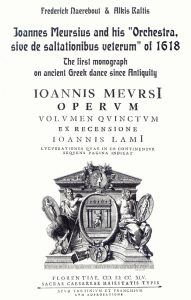 Joannes Meursius and his “Orchestra, sive de saltationibus veterum” of 1618. The first monograph on ancient Greek dance since Antiquity (with Frederick Naerebout). Athens, Dora Stratou Dance Theatre, 2003, 85 p.
Joannes Meursius and his “Orchestra, sive de saltationibus veterum” of 1618. The first monograph on ancient Greek dance since Antiquity (with Frederick Naerebout). Athens, Dora Stratou Dance Theatre, 2003, 85 p.
by Frederick Naerebout & Alkis Raftis
Publisher: Dora Stratou Dance Theatre & Greek Section IOFA
Scholiou 8, Plaka, GR-10558 Athens, Greece
Tel. (30)210 324 4395; (30)210 324 6188; fax (30)210 324 6921
www.grdance.org mail@grdance.org
85 pages 30.5 x 22.2 cm
Year of publication: 2003
ISBN 960-86150-5-4 9608615054
A reprint of the Leiden edition by Gronovius, an account of Meursius’ life, comments on the work, index of dances and a selected bibliography of the 100 most important works since 1618.
A fundamental work in dance scholarship and at the same time an informative reader for historians, archeologists, philologists, as well as for music and theater researchers.
The authors are two of the world’s most renowned dance scholars. The publisher is the national institution for Greek dance, which has a long list of the most serious publications to its credit.
Also availabe as eBook
Ask the Dora Stratou Theater for the Greek translation by Yannis Katsantonis
Ζητήστε από το Χοροθέατρο “Δόρα Στράτου” τη μετάφραση στα ελληνικά από τον Γιάννη Κατσαντώνη
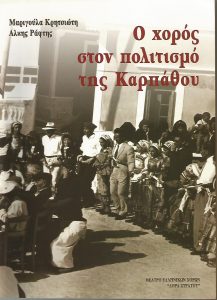 Dance in the culture of Karpathos (with Marigoula Kritsioti, in Greek). Athens, Dora Stratou Dance Theatre, 2003, 474 p.
Dance in the culture of Karpathos (with Marigoula Kritsioti, in Greek). Athens, Dora Stratou Dance Theatre, 2003, 474 p.
by Marigoula Kritsioti and Alkis Raftis
Publisher: Dora Stratou Dance Theatre
Scholiou 8, Plaka, GR-10558 Athens, Greece
Tel. (30)210 324 4395,
fax (30)210 324 6921
www.grdance.org mail@grdance.org
Publication date: 2003
477 pages 24 x 17 cm
ISBN 960-7204-17-4
An in-depth study of the dance as a social phenomenon by the two foremost dance researchers in Greece. Ten years of fieldwork in all the villages of the island, interviewing aged villagers who had taken part in the festivals, weddings and other celebrations in the old times when dance was a centrtal part of the culture.
Keywords: Greece, Dodecanese Islands, Karpathos, dance ethnography, anthropology, sociology, field research, customs, etiquette, values, identity, evolution of the dance with time and external influences.
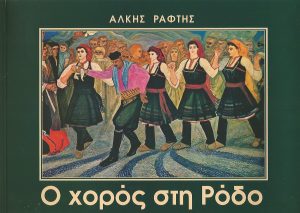 The dance in Rhodes (in Greek). Athens, Dora Stratou Dance Theatre, 2004, 154 p.
The dance in Rhodes (in Greek). Athens, Dora Stratou Dance Theatre, 2004, 154 p.
(in Greek)
Author: Alkis Raftis
Publisher: Dora Stratou Dance
Theatre
Scholiou 8, Plaka,
GR-10558 Athens,
Greece
Tel. +30 210 324 4395;
+30 210 324 6188;
fax +30 210 324 6921
www.grdance.org mail@grdance.org
Year of publication: 2004
154 pages 19.5 x 28.5 cm.
ISBN 960-7204-18-2 (9607204182)
A luxury album including the corpus of knowledge on dance on the Island of Rhodes, from the antiquity till the present.
Full color illustrations, engravings, archeological finds, photographs – most of them hitherto unpublished.
Accounts by travellers of the 18th and the 19th century, gleaned from rare books.
A field research carried out by the world’s most prolific writer on dance. Dr. Alkis Raftis, a university professor of sociology, considered as the father of dance scholarship in Greece.
Ο χορός στη Ρόδο
Συγγραφέας: Αλκης Ράφτης
Εκδότης: Θέατρο Ελληνικών Χορών “Δόρα Στράτου”
Σχολείου 8, Πλάκα, 10558 Αθήνα
τηλ. 210.324.4395, 210.324.6188, φαξ 210.324.6928
mail@grdance.org www.grdance.org
154 σελίδες 19.5 x 28.5 εκ.
Ετος έκδοσης: 2004
ISBN 960-7204-18-2

Traditional dancing in Rhodes
by Alkis Raftis
Introduction
I collected the material recorded in this article from elderly musicians and dancers in about twenty villages of Rhodes during the months of July and August 1983. Throughout this period I was interviewing inhabitants almost daily, each interview lasting an average of two hours. At the same time I was researching the bibliography, and questioning a number of Rhodians, on the subject. I was conducting a survey of the island with a view to writing a book about customs connected with the dances of Rhodes. However, I was subsequently unable to continue my research with the aim of complementing and cross-checking a number of points. As the years passed, I learnt that one by one my informants had died (they had been in their sixties or seventies). This fact persuades me to publish now a part of the material in the hope that some one else will manage to continue the study before it is too late to do so.
A methodological drawback of the research (ah, teacher, isn’t that just what you taught us?) is that I began it with the presumption that the dance customs of an island with about forty villages would be of a homogeneous nature. Thus my investigations were widespread, whereas I should have concentrated my research on a single village, supplementing my findings from its neighbors. Fortunately, it became apparent in the course of my study that the differences between one village and the next were not so great as in other regions. I have, therefore, assumed that in Rhodes the differences are due mainly to the personalities of the leading figures at any celebration (the violinist, vocalist, and most accomplished dancers). These are the individuals who establish the practices of each village by exercising their own preferences, drawing however upon the stock of music and dances which would seem to be common to all the villages. This may be explained by the fact that there have not been movements of populations, as well as by the geographical character of the island which has permitted easy communication between them. Another reason for this similarity is that each instrumentalist has usually been the pupil of a skilled player in a village other than his own, and so has introduced melodies from elsewhere to his native place. Nonetheless a more detailed study should make due allowance for the small if characteristic differences between one village and the next.
What I do know is that I collected far more material than I had expected. People were very willing to talk, they had clear recollections of events and were glad to recount them. Things are not invariably like that in other regions of Greece. But in Rhodes, as everywhere else, dance behavior at contemporary weddings and festivals (paniyiria) is a rather sad spectacle and only on rare occasions is it reminiscent of bygone days. Consequently there is little to be learnt by participant observation: one must rely wholly on interviewing.
Rhodes stands out above the rest of Greece in respect of its highly developed tourism, which preceded that of other parts of the country. One would therefore expect traces of traditional life to have vanished sooner. But I found no evidence of this, perhaps because the bulk of tourist activity is concentrated in the city of Rhodes, which lies at one extreme of the island, and at points on the coast where visitors stay in large hotels and move around in groups.
Use of the present tense does not imply that the event described occurs in our own day, but refers largely to the years prior to 1950, after which customs began to lose their hold. The past tense applies to events that are even older, some of them dating to Ottoman empire days, prior to 1914. Idiomatic or dialectical words and phrases appear in inverted commas. Even where they do not so appear, most phrases are reproduced precisely as they were spoken; thus the text is for the most part a compilation of the words used by the islanders themselves. I have taken their sentences one by one from my notes and arranged them thematically, concerned only that they should make sense. To this extent I am not the author of this text, but only of such generalizations and interpretations as occur in it.
General remarks on the dance in Rhodes
“The dancer” is not just any one who joins in a dance, but the person who dances particularly well, whether male or female. Female dancers who accompany a man in a dance are known as his “koustieres”. Only when it comes to European dances are they called “dames”, while the man is usually referred to as the “kavallieros”: “Your kavallieros, dear, your dancing partner”. The word “koustiera” (elsewhere “koutiera”) must derive from the medieval costiere meaning a flanking figure (from which comes the French word côté), in other words simply the girl or woman beside a man. The same word “koustiera” is used to describe the stone adjacent to a corner-stone in wall masonry.
Every male dancer has his “koustieres” on his left side and never fewer than one, as two men never dance beside each other. A dance commences only when at least two dancers, each with his “koustiera”, are linked together; “Come, let’s link together” is the usual invitation. But others must join in, too, or else the dance (in Greek the word stands also for chorus) is not fully engaged. They speak of the dance being “immediately engaged”, and “so-and-so engaged in the dance”. Thus initially someone forms a link (exceptionally, men may link together provided women immediately interpose themselves between them); the dance is engaged later. The reverse occurs when the lead dancer “disengages” or “breaks off” by letting go of the hands of the two dancers to the left of him (the dancers are linked together in the familiar manner of crossed arms) in order to perform agile leaps and turns; a dancer “cuts out” when he withdraws from the circle of dancers. a woman will cut out if she has a weighty reason for leaving the dance, but is not permitted to break away in order to make the agile movements that are the prerogative of the men.
The man who leads the dance is “in the front”; he is “the front link” and has “taken the front position”. There is a “kanaki” (a laudatory verse) addressed to the groom with his bride which runs: “Stay in the front with the vine withy (in your hand)”. The lead dancer may perform twists and twirls, leaps and cross-steps, he may squat and slap his legs with his hands, or weave in and out of the circle.
The lead dancer shakes his body, “he plays shakes”; “he has a strong shake”, “he lets go of his koustiera and bends and twists”, “he leaves the woman and performs “tsalimia”, then he engages with her again”. “Crouch, go down on your knees till your breeches touch the ground”. These movements were not called “figures”, that is, mere variations of established steps and movements. When you’ re out in front you can’t jump about and sign; only later when others have linked hands with you will you sign.” “Only the leader is called a dancer; he ‘s the one who starts the dance and ends it.”
When the one in front has been dancing long enough the man at the end of the line “cuts adrift” from his koustieres, that is, he leaves the line, abandons the circle and starts out in front waiting to take the lead. As the lead dancer approaches he starts to dance again to show him he wishes to go ahead of him, says “To your health!”, and engages in the dance with his koustieres always on his left side. He may leave the lead dancer to make another full circle, for it might be discourteous to wish to link up at once. The man now in second place continues to dance in the circle until he reaches the end position when he may abandon the dance, taking his koustieres with him.
Such would be an ideal performance. In practice, though, it is often a dancer from the middle of the circle who stands out in front or a spectator who makes straight for the lead position instead of entering the circle and linking up with his “koustieres” somewhere around the center. “If the other fellow ‘s a rascal, he won’t wait. You should dance another round, but if he insists on linking up before you ‘have done one then you have the makings of a squabble”. It is a fact that most arguments are over places in the dance.
According to this pattern, in which each man has his koustieres on his left, there would always be a woman at the end of the circle. But there must always be a man in this position: they never leave a woman in last place in any of the dances. If a woman does end up there, then a man will at once be sent along to join the dance from among the bystanders (“Go and support the lasses”), or a man will leave the center to link up with her; alternatively the last man will move his koustieres to his right side. The last man “supports the tail”, or “holds the beans”. This position becomes rather belittling if one man fills it for long; each male dancer should fill it at some time or other. If someone doesn’t know how to dance well he is said to be “sitting on the beans”; he leaves the man on his right to cut out and go into the lead. In Marts the last man is named “the pillar” of the dance because he is immobile, to the extent that he makes no crouching movements: “It’s the same on a threshing-floor, where the donkey is yoked and goes round and round a pillar”. While it would be offensive to a woman were she the pillar, it is not so to a man. The lead dancer takes with him as it were his pillar, he and his pillar making a kind of pair. If one of them tires he changes place with the other; if he wants to withdraw from the dance he must first find a replacement who will support his koustieres.
The “koustieres” attached to any one dancer must be sufficient in number, or else his dancing will seem lack-luster. “The man rises with a single “koustiera” and she takes her friends with her: a “koustiera” cannot dance alone. In the old days when there were no instrumentalists, if you took one “koustiera” with you fifteen followed.” It is to be understood that any koustiera is a relation of the man or from a closely connected family. “Married women dance only when they are related, else the man falls under suspicion.” “My husband was not a dancer and used to ask other men, always his relations, to invite me into the dance. He’d have me sit down at table, too. He was good-natured, not jealous.”
The dances
The Tourkikos (Turkish) dance
This dance is also called Tourtsikos, Zeibekikos, Zeibekistikos, Zeibek (the name by which it was known in the dance-troupe competition held at Kremasti during the Italian occupation) and Monachikos (solo). Confusion with the real Monachikos arises from the fact that this is also a solo dance in that the dancer is out on his own and not attached to the circle. Today, even those who know it as the Tourkikos, refer to it as the Monachikos out of patriotism. Once upon a time a young man danced the Tourkikos and the next day the village teacher chided him: “So you danced the Tourkikos, the dance of the people we have no use for?”
Many kinds of melody accompany the Tourkikos: Baud-Bovy records three melodies in nine-time. One is the melody of the song “An ox-cart is passing by”; the others are wordless in 2.3.2.2. and 3.2.2.2. time respectively. “It’s similar to the Zeibekikos, it’s aptal-chavasi.” There is also a slow and a quick-step Tourkikos.
The steps are the same as those of the Aftalikos, or Eptanikos (Aptalikos), but some hold then to be as in the Tsifteteli or the Karsilamas. It is an improvised male dance performed by one or, more rarely, two dancers who do not hold each other by the hand or arm. More rarely still, it may be danced by a woman, but only if a man asks his wife to dance with him. A man who was dancing the Tourkikos in Aphandou village made a sign to the players to stop their playing and danced without accompaniment until he gave them another sign to resume; he stopped them in this way two or three times. Some dancers performed on table-tops. “There was a dancer during the Turkish occupation who drew his knife and plunged it right through his calf muscle and danced with it there to impress the onlookers. He lost a lot of blood. I didn’t see him, it was my mother who told me about it.”
Men would bring musicians to the coffee-house and dance the Tourkikos, no women taking part. Turkish-Cretans used to come and dance the Zeibekikos, but the Greeks performed it better, more stylishly. The Turks, who joined in the Greek festivals when invited by a Greek friend, were able to dance only this one dance. When it was time for dances requiring participants to link hands or arms they either sat down and looked on or left. In Archangelos “at Carnival-time Zeibekikos dances were held outside the church; the dancers held knives in their hands and clashed them together during the Tourkikos dance. The women dress up as kamouzeles (camels).”
The Tourkikos dance gives the performers an opportunity to display their individual virtuosity and artistry. It is a more difficult dance then the Sousta: one must be an expert to perform it. “Yiorgos Avyenikos from the village of Maritsa won the 300 franc prize in the competition at Kremasti.” It is the only dance which a dancer may actually “order”, or request; such a request is tantamount to an instruction to the instrumentalists. Anyone else rising to his feet would be provoking a quarrel. It is always the first dance performed at a “glendi” (party) or on a church feast-day, and is followed by a Monachikos or Syrtos dance; it is not done to interrupt other dances in order to perform the Tourkikos. It is only at weddings that the married couple will first dance the Syrtos; the men then dance the Tourkikos, after which all dance the Sousta. A very early form of Tourkikos danced by elderly men was one with the song “Baglamadakia play for the young dervishes to dance”. Flevaris, a well-known violin-player, learnt it from Pontikas who was also a distinguished instrumentalist”.
The Monachikos dance
All dances in which the performers do not hold hands go by the name of Monachikos (solo), so there is some confusion as to which is the real Monachikos – at least among those concerned with such details nowadays. Whichever it is, it always comes after the Tourkikos. When the islanders talk of the Monachikos they may be referring to the Tourkikos, the Karsilamas, the Konialis, the Ballos, or the Monachiki Sousta: Baud-Bovy has noted “a kind of Sousta, the so-called Manachikos or Monachikos”, but has not recorded the melody. The distinction lies essentially in the rhythm: nine-time in the Tourkikos and two-time in the Monachikos, though this seems to be of little moment to the dancers for they dance in a free style of their own.
“After a Tourkikos he liked to dance a Ballos, the two performers facing each other. We called that Karsilamas. It’s a kind of Syrtos with improvisations and an amanes.” “The Monachikos takes over from the Syrtos, when the woman dancer comes in to her own. The Monachikos is also known as the Assos. When it begins, everyone sits out leaving only the lead dancers, both male and female, performing the Assos. It’s the same as the Ballos.” “They hold hands in the Ballos, but not in the Monachikos.” “It’s called the Koftos (Cutting) Ballos because the others cut out leaving just the couple in, as in Symi Island.” “They’d tell me to play the Monachikos and then ask “Link us”, then I’d switch to the Sousta.” “We (the instrumentalists) would switch to the Monachikos on our own, or they’d give us a sign to do so. The Monachiki Sousta comes after the Tourkikos, when they spin round.” “It’s a Karsilamas but the steps are as in the Sousta.”
These remarks suggest there is no set pattern for the Monachikos, but that the dance varies according to the village, the musician, and the individual dancer. It succeeds the Tourkikos, of clearly alien origin but now firmly established in the local repertoire, becoming the Sousta, a purely indigenous dance. Sometimes it assumes a nationalistic character: “It’s a sort of Tsamikos in 2/4 time, involving twists and turns, leaps, and leg-slapping. They used to play the tune “My beloved Athens and Piraeus, my beloved blue-and-white flag”, but the dancer did not sing”.
Though it can be danced solo, it is chiefly a dance for a couple, the two dancers dancing in step and usually face-to-face, while in the Tourkikos their movements are unrelated. A woman will dance the Monachikos much more readily than the Tourkikos. “A Turkish woman danced the Monachikos with my father”. At a marriage-feast in Archangelo the newly-married pair will open the dancing with a Monachikos, the others singing the while. The groom’s father will also dance a Monachikos with his mother. It’s also danced on the way to church, the wedding procession halting at any suitable point. The singer sang: “Dance a Monachikos at the entrance to the best man’s lane”.
As this dance is open to individual interpretation, the dancer “pays the piper”, that is, he pays the musicians before he takes the floor and, if he so wish, may call for the tune of his choice. In the case of other dances, the dancer approaches the players in the course of the dance or when it ends; in other words, he does not call the tune.
In the course of a dance in which the dancers hold hands or link arms the violinist may switch in to a Monachikos without any sign from the lead dancer,. The vocalist may call for this in a rhyming couplet: “Play the Monachikos, so it will occur to me what to sing”.
The Sousta dance
The Sousta (spring) is the chief dance of Rhodes: “It was no dance at all without a Sousta”. “In days gone by the used to call it the Pano. That was when they still played the lyre”; “and they switched to the Pano”. Monachikoi dances are only a prelude, as it were, to the Sousta which everyone is waiting to dance. At a wedding in Koskinou they always start with the Sousta, the other dances coming later. They used to dance it for two or three days and nights on end. Time was when they would sing as they danced the Sousta, fast though it be: “they began to sing as they danced”. They seldom danced the Sousta in Rhodes city. The left leg has to be dragged as if it were paralyzed. The lead dancer does not request a particular Sousta, but if he wants a change may say “Play us a Syrtos”.
Every village has its own Sousta. The Embona version includes agile leaps, while in Asklipios, while its is still a leaping dance, it is more staid. The most renowned Sousta is the Embona one, being more impressive than the dance seen in Archangelos or Salako. A different rhythm colors the Chalki dance. The Kremasti and Trianda versions are more even in character. “The best Sousta, the most delicate, is the one from Asklipio; the villagers leap more agile. Asklipios folk are outstanding in the Sousta: they dance as one”. “The villagers of Embona and Kastellos are the best dancers. The Sousta danced in Embona is the genuine Rhodian Sousta. The other islanders try to copy them.” “They leap about as they dance the Sousta in Embona.” “If the instrumentalist dropped down dead the villagers of Chalki would go on dancing”.
The Ballos dance
“After the Tourkikos, one wanted a Ballos. A kerchief is held waist high between the dancer’s two hands; he moves backwards and forwards, shaking the kerchief.” Two people dance the Ballos: it is a Karsilamas. The married couple dance it on their own, facing each other. “The Ballos and the Monachikos are one and the same. Symi islanders called it the Ballos, we (in Paradeisi) the Monachikos.” “They dance and sing the Ballos-manes like the Syrtos. The Syrto-manes is the same thing, when the Syrtos is accompanied by song. But there’s no such thing as the Sousta-manes: they call that the sung Sousta. You dance the Ballos-manes (tune) solo.”
The Kritikos dance
This is the dance now performed by dance groups throughout Greece and known as the Rhodian Pidhichtos (leaping dance). It must have been so named by a dance instructor, because it is unknown by this name in Rhodes. Rhodians always called it Kritikos (Cretan), the name by which it should be known. They probably acquired it from Cretans who took refuge in Rhodes at the time of the Ottoman occupation of Crete, but no earlier since it is not to be found in islands such as Karpathos and Kassos which lie closer to Crete.
The steps are as in the Cretan dance which came to be call the Chaniotikos, though they are more springy and have a different, quite specific, melody. It was not a customary dance, and in many villages was quite unknown. It follows the same procedure as the Sousta, with koustieres and other such features.
The Kalamatianos dance
Children used to learn the Kalamatianos (from Kalamata, a town in Peloponnesus) dance at school, singing songs of a patriotic character as they danced. On the 25th of March (national holiday of Greece, commemorating the revolution against the Turks) each year they would dress as Evzones (soldiers of the Greek national guard). This was largely the situation under the Turks and at the outset of the Italian occupation (1912-43) when tolerance was shown, but circumstances changed around 1930. The children’s teachers were either from Greece or were Rhodian women who had studied in Athens. They occasionally danced the Kalamatianos on local feast-days. They learnt no other dance at school.
The Tsamikos dance
This dance seems to have been generally unknown. In Soroni: “After 1912 it was danced by a father wearing baggy trews and supported by one of his sons; then the son took over. He learnt it from his master (his father) who was from the Mani. The leading dancer would plunge his knife in the ground and somersault over it. He also juggled with his knife. Once he danced to the music played by an Italian ensemble”.
The Zervodexos dance
The instrumentalists vary the melody as the dancers are moving forwards, whereupon they reverse direction. In slow time the movement is to the left – a difficult movement; in fast it is to the right. They link hands as for the Sousta. The Zervodexos (the word means “left and right”) is a kind of Syrtos, danced to the melody of “Mia Kyriaki imera” (It was one Sunday). It begins slowly, the dancers moving to the right. Eight dancers take part, the men and women in alternate positions, the two groups of four forming a circle, for at the time they held their dances indoors. It is performed towards the end of wedding celebrations, and if folk are in high spirits during any other merrymaking. “We rarely played it, and it was abandoned when Syrtos dances became the fashion. It used to be danced in Aphandou with different steps and to a different melody, without words.
The Symi Sousta dance
They called it the Symiakos, the Symian dance, in Kremasti. Symi islanders living in Rhodes used to dance it in pairs but the man did not stalk the woman, as in Symi, but moved in circles round her.
The Rinaki dance
The dance that usually ends a wedding celebration, the other being the Kato. It has its own music, a sort of Karotseri melody. The dancers hold each other round the shoulders, as in the Vlacha dance, and make the same steps.
\
The Serviko or Servikos (Serbian) dance
Men only used to dance this, holding one another round the shoulders. It resembles a fast Vlacha.
The Vlacha dance
Danced on any occasion, the dancers, both men and women, hold each other round the shoulders. The melody is the one of the song “From a foreign land and far away”. It is known also as the Servikos, and sometimes is performed at the end of a wedding. “The leading man pulled the others after him. You had to be a good woman dancer and react fast”.
The Karotseris (coachman) dance
Some know it as the Servikos, others as the Vlacha. Again, the arms are thrown around the shoulders. In Kritinia “they didn’t know the Servikos and Karotseris. I learnt them in the island of Nissyros, and introduced them here. There was someone else who knew them, too, and gradually they caught on. Women seldom danced them for the men leaped too fast. We also call it the Chasapikos.”
The Tselis Andras dance
Many dancers, both men and women, held each other with one hand on the shoulder of the adjacent dancer. The Tselis Andras (bold man, from the lyrics of the song) used to be danced mostly in Aphandou and Archangelos, though differently in each place. In Aphandou they moved to the left, hands held in the usual manner or crossing each other.
The Tzenevetos dance
“It was performed only in Aphandou to a single melody; men and women danced in a circle, hands held and arms crossed; a plain dance, nothing showy; the song is full of banter. It’s danced on the last day of a wedding feast, on the Wednesday, in the closing celebrations”.
The Konialis dance
Danced by one or two men, there was one man who danced with a couple of glasses in his hands. In Konialis (from Konia, a town in Asia Minor) they brandished knives. “Just one man danced it here; he gripped the table in his teeth and lifted it, squatted low and lifted it again with its glasses.” The Konialis resembles the Tsifteteli. They used to call it the Vlacha or Hasaposerviko. It’s a kind of Syrtos Zeibekikos, rather like the Arapikos. “People from our village often went to Asia Minor and got to know the dances well”. “Men and women held each other round the shoulders in Konialis.” “It’s the Bes Kazali or Bes Katzali, and is danced solo”.
The Kato dance
The Kato (low) dance is danced solely at the end of a wedding celebration by the couple’ s relatives, the two families jointly singing wedding songs, sometimes of a persuasive or laudatory nature: “We gave you a good groom, a good bride”. Hands are held as in the Sousta and the steps are a walking rhythm even elderly folk must join in.
In Yennadi the dancers are linked “with their arms resting on the shoulders, and they sing as their feet move backwards and forwards. The groom and his bride lead the dance, the rest following. In the Kato the groom’s relations would be paired with the bride’s. And we’d play the melody around the “sperveri”.
In Vati they hold hands as in the Sousta, the groom and the bride first and then each of the male relations with his koustiera, the married couple now at the end of the line. They invite the dead to join in: “Bring so-and-so along”, “Ah, if only my mother were alive”, “Come and see your daughter”; and there are tearful scenes. Young folk under seventeen don’t take part. In Kallithies and Archangelo they dance the Kato first while singing “Come among us, Holy Virgin”. They form up with one group of relations in the lead, then the married couple, and finally the other group.
In Koskinou the dancers leave the floor after the Kato except for the married couple. Elsewhere the Kato is called the Sperveri, and is danced less often. In Maritsa the Kato is danced on the second day of the wedding when the couple is awakened. The bride and groom are in the house and the door is closed; when the singing starts outside they open the door and begin to dance the Kato within the house. The song accompanying the dance praises the newly-weds. Hands are held as in the Sousta, arms crossed over each other. In Aphandou they call the Kato Androino; it’s the first and last dance performed at a wedding, being followed by the Sousta in the beginning.
In Lardo the Kato is accompanied by flattering verses (“kanakia”). For the most part the dancers are the singers, too, but guests also join in. It’s the last dance of the main celebration of the wedding, after which the close relations stay behind and dance the Sousta, their arms on each other’s shoulders, in this order: groomsman, groom, bride, maid of honor, and then the relations. Each of the sponsors holds a lighted candle.
The Sympetheristikos dance
The Sympetheristikos (meaning “of the in-laws”) is a particular dance performed in Maritsa by the families of the bride and groom in the village square before they enter the church. The bride and groom do not join in, but remain seated on one side. Hands are held as in the Sousta; the music is peculiar to the dance, comprising two musical phrases, without words. The groom’s father and his relations lead off followed by the bride’s relations, but occasionally this order is reversed. Only brothers and sisters and cousins participate. Even a grandfather of ninety years had to join in and his elderly wife had to put on a white kerchief to dance. That was the only dance performed at that time.
The Vatani dance
In Maritsa “on Saturday evening the musicians would leave the groom’ s home when the meal was over, taking the bride’s family with them, and make for the couple’s new home (that is, carrying the bride’s dowry, for in those days the groom went in the trousers he was wearing; in other words he left his home without a patrimony). There the two kindred groups were brought together; they sang the Sperveri and danced the Vatani. The couple sat out, neither dancing nor singing. The steps are the same as in the Kritikos, one forward and two back”. Hands are held as in the Sousta. It’s the same in Asklipios. The Sperveri is not a dance; the Vatani is a linked dance like the Sousta. In Kritinia it’s seen only at weddings; there they hold hands as in the Syrtos, usually women only but sometimes men too.
The Gaitanaki dance
A mixed dance performed in Kritinia and favored chiefly by women. It is accompanied by the song “You sewed five ribbons on the hem of the dress” (the speaker explained the ribbons were always five in number) or “My bushy orange tree, my russet apple”. At festivals and weddings it is usually danced like the Sousta. In Aphandou the Gaitanatsi is a satirical, mixed dance, the arms held crosswise.
The Tsakiris dance
In this instance it is the groomsman who is extolled. The dancers, both men and women, hold each other with crossed arms. The song is “The groom is worth his weight in gold”.
The Gries (old women) dance
Danced at the wedding feast but only by old women, and accompanied by the song “Come, old women and young maids, join the dance and link hands”.
The Michanikos (sponge-diver) dance
A well known but not widely distributed dance, requested by outsiders, especially islanders from Chalki. The lead dancer held a staff in one hand.
The Piperi (pepper) dance
“This is danced for amusement. Someone holds a length of rope and ties a knot in his kerchief or belt and lashes the others in jest. It’s all good fun, no offense given or taken”. It is danced in all the villages, nearly always by men. On the second or third day of a wedding in Aphandou they come out on to the streets, collect chickens and food from the houses, and dance the Piperi and other dances in the village squares, accompanied by musicians and the newly-weds.
T’ Alamoustou dance
Another of those amusing dances, like the Piperi, performed only by men either at the end of the wedding-feast or when they are making merry on their own and are in high spirits. As they dance with hands joined as in the Syrtos they place one leg over their arms. They sing “Alamoustou, moustou, moustou, and aromatic sweet-basil” or “I had a good wife who ate bread enough for ten”, and leap in the air. The dance is known as “Dog-nuptials” when, their arms beneath their legs, they behave as dogs mating.
The Alazinga or Alasvinga dance
A dance similar to the preceding one; only the words are different. On the second evening of the wedding “they dance the Alazinga. Alazinga is the name of the dance, Piperi is the name of the song. They say “Whoever wants to may leave”, then they close the door and begin the dance. Many women left at this point.” “As the dancing ended on the Sunday evening of the marriage, the girls left, only men remained behind, not even married women stayed on. Then they danced the Alazinga. The newly-weds didn’t take part, but were present. The lead dancer sang, the others repeating his words; there were no miming movements, the performance resting on the song. At the end the rhythm quickened, the dancers placed their legs over one arm, and holding kerchief moved forward in leaps.”
With my aunt Irene
This is a Syrtos, but with miming gestures, danced by elderly men and women only in Aphandou.
The Sotira dance
The dancers sing “One Sunday I passed by Saint Sotira’s and a wretched widow was washing her skirt”. At every second step they bend their knees with their legs outspread.
The Arapikos dance
A solo dance, mostly for men, like the Syrtotsifteteli, with shaking movements. It was danced at weddings. “Two people (would dance it), like the Monachikos but with different steps; it’s similar to the Tourkikos.” “Only Krizas used to dance the Arapikos. He’d been brought up in Asia Minor, and danced it like the Konialis. Others learnt it from him later on”. “Two men dance it, making indecent movements as if copulating; that’s after midnight when they’re in their cups.” “The Kamouzeles used to dance it in the street at Carnival time”. “Two men would dance the Arapikos during Carnival. They’d first make two circles, then one would drop down as if dead and the other would mourn him; then he’d get up and they’d dance together again”. “They don’t dance the true Arapikos at Carnival time, but another dance that resembles the “camel dance”, performed as bears might dance it. “The Kamouzeles danced the Arapikos on Shrove Monday; no women took part. They went outside the village. It’s a comical dance.” “Sponge-divers brought it back from the Barbary coast. A man and woman can dance it together; the woman lies on the ground and the man lifts her up and cradles her as he dances”.
The Ovraikos (Jewish) dance
The Jews who lived in the Old City of Rhodes for centuries had their own dances. A study has been made of the dances of the Jews of Rhodes who emigrated to America. Panayiotis Balos of Embona, an eighty years-old violinist, told me: “I used to play the Ovraikos for Avramis who kept a shop in the village. He’d hold his head and dance. I don’t remember how it went. It was fast, like the Konialis. They moved their legs backwards and forwards”. Others say the Ovraikos was a solo dance and was like the Arapikos. “Sevasti, Stavrakis’ wife, used to dance the Ovraikos. She was the only one that could. She had seen the Jewish women who came every Saturday to Koufa’s (where the airport is today) and watched them. She stood very erect, her feet moving rapidly”.
European dances
European dances began to become known when Italy annexed the Dodecanese islands. The violinists slowly mastered the melodies and from the 1920s onwards villagers started to perform these dances. There was a dancing instructor in Rhodes city who taught them. Country folk drew the line at dances requiring partners to embrace, though they held each other quite closely in the Sousta. “They played the Tango and Borka for the doctor who had studied abroad.” “On leaving home the couple dance a waltz or a tango or a mazurka, and then everyone proceeds to the church.” “Then came the dances in which they held each other tight: the Broom or One-step. Ten couples would dance the Borka (polka), one man on his own clutching a broom. When they shouted “Changez les dames! (Sangeleta!) he’d look around for a girl to partner him.” “During the Borka couples would dance a mazurka. One of the dancers would shout out “Promenade!” and they’d change partners. A cad would cry “Promenade!” to take a girl away from her beau”. The Borka is a slow waltz.
The dance cure at Saint Merkourios’ chapel
“When someone had earache he’d go to the little chapel of Saint Merkourios. He’d be locked up there, and he’d dance all the dances he knew till he was cured. They used to say, “He’ll dance at Saint Merkourios”. “He’d put a measure of barley before the Saint’s image for his horse to eat and some oil from a sanctuary lamp in his ear and dance before the Saint and leap about all alone”.
The dancer’s attire
“A good dancer must wear good clothes: it’s your dress that shows off. He must have hand-woven breeches – breeches from Asia Minor if he’s an only son, or at any rate a young unmarried lad – a yellow and red waist-band with tassels from Kastelorizo Island, ankle-boots, waistcoat, a felt cap, a collar embroidered with silk, a white kerchief also from Kastelorizo fastened to the belt, a colored neckerchief (a large one for a woman)… A married man would leave them all to his son.” “I used to wear felt breeches; my drawers were made of eleven piks of cloth (about seven meters). when I twirled round as I danced the bag of my breeches would strike the woman next to me.”
There was no right or left footwear for women, which is why they were called “singles”; they were worn in the fields. The best were white (“doubles”); they were worn around the village so they didn’t get dirty. “Doubles” were what men’s ankle-boots, worn on formal occasions such as festivals, were called; women wore them less often. All the villages participated in the Kremasti competition, and it was the Embona women who wore boots with no heels that took the prizes: you’d have thought they were walking on air.” They wore wooden pattens indoors. When men and women wore shoes they would wear stockings and breeches. Men’s breeches were wide, the women’s narrow.
They wore a shirt in such a way as to display its embroidery, and a skirt. Men and women wore ankle-boots in the lowland villages, but more often shoes and stockings, the latter white or colored but never black. The people of Salako took pride in their embroidered breeches. The breeches worn by Embona women were like bloomers and not visible. Embroidered breeches were worn in Salako, Fanes, Soroni, and Archangelo and were always white. The skirt was the same in every village, long in Salako and short in Embona. It was white or blue – or black for widows – and lacked ribbon decoration. In Amalia they wore a “sack”, a kind of chemise, over everything, a custom originating in Paradeisi. In mountain villages apron ribbons are a matter of taste, for they have no surviving symbolism. Greeks wore breeches, Turks baggy pantaloons.
Musical instruments
Musical instruments are commonly known as “paichnidia” (playthings): “they brought some good paichnidia”, “he plays a good instrument”. The “play-man” is the instrumentalist. The most important instrument used to be the “lyra” (three-stringed fiddle), replaced early this century, even before the Italians came, by the violin. The lute, known as the tamboura, held second place in an instrumental ensemble or, more rarely, the dulcimer (santouri). The clarinet was introduced by the Italians, and accompanied the Sousta. There was also the trumpet (cornet, trombone), but such wind instruments accompanied dances other than the Sousta. The tsambouna or touloumi (bagpipes) were lesser instruments and were never heard at festivals. They were played by a number of people, mostly shepherds, but only at private gatherings where it might accompany the Sousta. Only the Turks had percussion instruments; where Turkish women gathered together they would dance to the rhythm of tambourines and cymbals.
Every village boasted its own fiddler and lutanist. Each village would bring its own instrumentalists to a public merrymaking, such as the Kremasti competition. “Every violinist played his own version of the Sousta. He’d learn something from his teacher, but would create something different of his own. Both the fingering and the bowing would be different. If there were two violins in an ensemble, only one of them would play the Sousta, while they’d all play other dance tunes together”.
An instrumentalist would not get up to dance unless he found someone to replace him. The fiddler could get up and go round the lead dancer, but not dance himself. Some fiddlers would show off by holding their instrument up in the air or even behind their head while continuing to play it. “There was a time when they’d raise their instruments and play close beside the dancer while walking forward in order to egg him on. But we didn’t do that: we played fiddles, and they couldn’t be heard. The violin is a much louder instrument, so the dancer would fork out more money that way and give it to the fiddler. Fiddlers made their own instruments, but not the violin-players.”
Instrumentalists who acquired a name for themselves and were invited to play in other villages were the violinist Miltiadis of Trianda village and the fiddler Pontikas of Aphandou. Instrument playing rarely ran in families, nor was an instrument connected with a particular occupation. Jews played the mandolin and sometimes the oud (outi). No woman ever plays a musical instrument.
Payment
To show his appreciation of a dancer one would call to him “Yeia sou!” (Health to you) and throw some coin to the players or attach paper money to their instruments. At Fanes village they used to throw gold coins to the dulcimer player or slap paper notes on his forehead. Before starting to dance you have to put something in the musicians’ plate or slip paper money into an instrument, much as saints’ icons were treated. Paper money was stuck on the forehead. A woman might do this for her husband or son, but never a young unmarried girl, for this would be to make a public spectacle of herself. Nor can a woman request a particular dance. A singer is not paid except by the householder who invites him. One throws coins to the violin player; previously one stuck notes on his forehead. Bystanders may do this on behalf of a dancer. It is also possible to dance without paying. Players at a festival are paid by the owner of the site; later one may give whatever money he likes. You have to throw something to the players before getting a woman to join the dance.
At Lardo, if someone wants to get others to contribute something in honor of the lead dancer, he shouts out: “The bowl for the leading man!”. He’s the first to throw something in to it, and the others follow. He may shout out this phrase as a signal that he wants to take over the leading position. The instrumentalists share their takings with the church. The players are always seated in the middle of the circle, the violinist often rising to his feet to play beside the lead dancer, staying close to him all the while. A bowl is put out to receive a collection for the church at a religious festival. Three dishes are put out at a wedding: one for the barber, one for the vocalist, and one for the musicians. Dancing does not take place near the latter’s dish, so payment takes the form of sticking notes. One metaliki, grosi (piastre), or metziki= 5 piastres. Musicians are not paid in advance, but in the course of a dance.
Clerics and the dance
There are great differences between one village and the next in respect of the priest’s attitude to dancing. “The dance music struck up in Nissyros, but no one began to dance. The bishop asked why this was and when told that a priest had to open the proceedings he pushed the local priest forward.” In Yennadhi and Arnitha it was the priests who lead the first dance. The story is told of a priest in Soroni who was a lutanist before he was ordained, and a dancer too; indeed he had won the first prize for dancing at Kremasti. After conducting the marriage ceremony for his daughter he played the lute and danced with gusto. In Kremasti the priest attends the dancing, but would bring shame upon himself if he or his wife were to dance. Once the bishop was observed beating time with his foot as the Sousta was being danced and attracted adverse comment from the people around.
Conduct of a dance
The dance begins
In Kritinia the men would assemble at the coffee-shops or in the church grounds and summon the musicians. Dancing in the houses was reserved for weddings; all other dancing was in the village square. The women came along when they heard the music playing; sometimes we rang the church bell (for men). When we were ready to begin the dance we formed up in a circle, the young lads sat on chairs in the center, the women stood outside the circle. Wherever you got yourself a drink you also got the chairs. The players were in the middle too; no one remained outside with the women, neither an old man nor a young one, The old ‘uns wanted to sing and stayed close to the players.” In Lardo they placed pine-wood torches on top of a pillar to provide light when they danced at night.
The invitation
To invite a girl to dance you say “Oriste” (come). You’d ask her father, if he were present, her brother or mother, if she’d come to the dance it was in order for her to join in.
If you’d fallen out with her family you didn’t ask her to dance. Between friends and relatives you could ask permission to invite another man’s wife. Men seldom danced alone; usually there were women there too. If you’d been once or twice to her parents’ house you could take her hand and get her to dance; otherwise her mother would address her sharply: “Child, he’s not to get close to you” – in other words he was to keep his distance so he couldn’t take the girl by her hand. “That’s what the kerchiefs were for: to keep hands away from the bosom. A woman might say to her husband dancing near to her: “Here, this man’s putting his hand on my breasts!”, and he would answer: “Don’t worry, they won’t shrivel!”
Courtesy required you to offer a girl a kerchief when asking her to dance, so no one could say “so-and-so’s daughter held hands with so-and-so”; otherwise she would offer you her kerchief. It is the man then who is obliged to make a show of offering his kerchief, shaking it out and giving a corner of it to the woman with whom he would dance. The lead dancer holds a kerchief by his left hand so he has enough space in which to leap and crouch, his right hand making patterns in the air. He doesn’t have to offer a kerchief to his wife, if he’s not intending to make any lively movements. Someone may be drunk and squeeze a woman’s hand; that’s what the kerchief is for. He may purposely step on her foot. “If you squeeze her hand, the girl may drop out of the dance”. So a man holds his koustiera by the kerchief in his left hand; the kerchief in his right hand belongs to the girl who is not his koustiera. Syrtos dancers hold each other with kerchiefs, and as in the Sousta both the first and the last dancers must be men.
Any man courageous enough to seek out a girl to dance with him must beg pardon of her father or brother or mother or of whomever is accompanying her. “If the father’s there, you’ll ask his permission.” There was a time when to invite a girl directly to dance was tantamount to a proposal of marriage. “A girl begins to attend merry-makings, with her father’s permission, at 16 or 17 years of age, when her thoughts first turn to love. Youths begin to take their place in company when they are 18. Whatever your age, you can’t sit down if your father is already seated until you are married.” A man from another village can dance only if he has a friend who will give him his koustieres. A woman can break in to a dance between two other women. When there are no women a man may dance with a man, but women do not dance together in public.
Each of the first, second, and third dancers wears a different air. The musician plays in accordance with your dancing: the better you dance, the better he plays. No one dancer performs the same steps as another, but follows his own instinct. If one is a good dancer, the rest will follow his lead. If you’re a good dancer the others will rise to their feet “to shower you”, that is, to toss money to the musician. “A star performer!”, all acclaim. “The rascal, he’s a winner!” “Your health, good man, you’re a fine lad!” Exclamations include “your health! Long life! Bravo! Opa! A splendid dancer!” A good woman dancer is recognized by the rhythm of her foot movements.
Squabbles
Rows may break out over a misunderstanding of the words of a song or a girl’s hand being squeezed. In the latter event the girl bridles and lets her brother or fiancee know about it. If you want to upset a dancer you interrupt his movements: “I’ve another turn to make and you come to cut me out?” A violinist from Maritsa recounts how he found himself in trouble: “One Easter outside the church I made a mistake in the order of playing and got a chair over my head.” “If you’re going to dance you have to be drunk; you can’t dance sober”.
Comments
Girls gave no occasion for a misunderstanding, but connived with their eyes. When the dancing was over and they were wending their way home they gossiped among themselves: “So-and-so danced with so-and-so. He loves her and wants to wed her.”
Learning to dance
The women used to teach each other. They would lock themselves into a house and sing unaccompanied. It was the same with the men, who learnt in a more easy fashion. In Paradeisi, “The women danced and sang on their own in the home. They’d invite along two or three young lads they were fond of. Each of them gave the violinist an egg and he played for them in the village square; they’d be lasses of 15 or 16 years of age. When we rang the church-bell the girls assembled and we danced, all of us youngsters. The girls learn from each other. One of them played tunes on a comb with a cigarette-paper; she could play anything.”
Occasions for dancing
Weddings
Corn was ground on the Sunday preceding a wedding. Relatives and invited guests brought along wheat for the wedding loaves. This provided an opportunity for a little dancing. On the Thursday they baked the honeycakes and again there was some dancing, mostly by women, without musical accompaniment. They even danced the Sousta without music, but singing the while, despite the derisive saying: “How can the mad dance without the fiddle and violin?”.
They might even dance on their own while white-washing the house. They went on foot to the church where the relatives might stop outside to have a dance or two. There was no dancing though on departure.
When the bride was from another village a celebration was held at the groom’s home on the Saturday, and on the Sunday (of the wedding) at the bride’s where the couple was to remain. During the three days following the wedding they danced at the newly-weds’ home, but first went to the coffee-house to get drunk and then made their way to the house. They dressed up as camels at the wedding and danced the Piperi.
Carnival
Zeibekiko dances were performed outside the church during Carnival, the dancers brandishing knives and clashing them while performing Turkish dances. Women dressed up as “kamouzeles” and jumped about with bells tied around their waist. They wore false noses and danced flirtatiously, like men with women; and there were elderly men dressed as kamouzeles (disguised carnival revelers). They mimed marriage, danced the Kato in jest, and pretended to give birth to a child and to cradle it in their arms. The kamouzeles acted the part of a pregnant woman. They danced the Arapikos, the Piperi, and all the other dances. “Everyone had to do something of his own to make the others laugh. One held a cord and pulled on it till an old roof-tile came out of his trousers while he was dancing”.
Festivals
Every village has its own dance for a major festival. Villagers from elsewhere were reluctant to join in such a dance and sought to be excused.
The Kouphas coffee-shop
At one time it was all the fashion to go to Kouphas near Paradeisi, where the airport is today. Stamatia Diakosavva, born in 1904, relates her memories: “We’d go along to Kouphas’ at one o’clock (midday) and sit down apart from the company. Young girls would sit on the parapets. That was every Sunday and on holidays: on the feasts of Saint Soulas, the Virgin, and Saint Nicholas. Dancing went on till ten and the girls left at sunset. Married women could stay if they were with their husband. Papamichalis who played the violin later became a priest. If he saw you were a good dancer his violin seemed to sing to you. You’d order the coffee-house keeper to “Take her a glass of syrup-water that one who’s in love with us”. Then you’d call over the old hawker selling pumpkin-seed and send him to give her a measure. When you got the coffee-house man to treat her on your behalf she could refuse the offer if she wished. You looked into her eyes, and if she lowered her head you went over to her and led her off in to the dance.
Other occasions
There was no dancing here at Easter, nor at Christmas or on Saint John’s feast-day. But they did dance on Koukoumas Day. In Rhodes city dancing was only in the houses: they had big rooms and courtyards where they could hold weddings and baptisms and lay on feasts. “There were three or four detached houses with vaulted rooms and there they held festivities with music on the initiative of the young folk on feastdays. I played for whatever I got, money or eggs”.
In wintertime, especially at Christmas, the young men of Maritsa would designate a house in which all the village folk were free to participate in the dancing. Every Sunday evening in summer there was dancing at the coffee-house; the women sat out on stools or stood around. At Easter-time dances were held in the forecourt of the church during the afternoons of Easter Sunday, Monday and Tuesday. From time to time in Kremasti, usually on a Sunday afternoon, the young men together with the village musicians would arrange a dance in one of the larger houses or on one of the village squares. The girls came along too – though always with a parent or elder relative – and joined in the dancing.
The Kremasti dance competition
The Italian governor Mario Longo attached great importance to local customs and in about 1925 proclaimed a dance competition in which all the villages were to compete in local costume. The competition was an annual event until the governorship changed hands around 1938, close to the outbreak of war. On the orders of the new governor, the mayor of Kremasti and a church committee undertook the organization. Prizes were awarded, and were usually won by the villagers of Embona. They and the people of Kastellos were the best dancers and wore the finest costumes. In both Kremasti and other coastal villages the costumes were of conventional island design, while Embona and Kastellos had their own particular hand-woven and embroidered costumes. The Kremasti festival falls during the nine-day period following the feast of the Dormition of the Virgin on the 15th of August. The dance competition was on the evening of the 22nd of August and was held in the church enclosure, one village performing after another. Six or seven villages entered, each with about fifteen dancers and its own musicians. The judging committee comprised both local and outside members. After the annexation of the Dodecanese to Greece an attempt was made to revive the competition, but it failed for lack of interest on the part of the nomarch (provincial governor).
Epilogue
The foregoing text comprises one part of an unelaborated mass of material collected in the course of research carried out in the various localities. It calls for a particular approach by the reader since it contains successive phrases uttered by a variety of individuals, some of which are irrelevant or contradictory. Most of the facts about these dances and the customs connected with them are unknown to contemporary Rhodians. Almost certainly they would have been forgotten sooner had not the Dodecanese islands remained under foreign sway until 1947.
We find a large repertory of dances divided into two categories, solo and linked dances. The arrangement of the dancers forming the circle is slightly different to that in Karpathos, but falls within the general framework of Dodecanesian dances, as do the dance customs associated with them.
Alkis Raftis
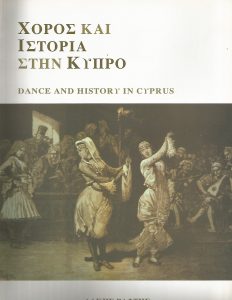 Dance and History in Cyprus (in Greek). Athens, IOFA, 2004, 133 p.
Dance and History in Cyprus (in Greek). Athens, IOFA, 2004, 133 p.
(in Greek)
Author: Alkis Raftis
Year of publication: 2004
133 p. 30 x 22 cm.
ISBN 960-86150-7-1 (9608615071)
Publisher: Greek Section IOFA & Dora Stratou Dance Theater
Scholiou 8, Plaka, GR-10558 Athens, Greece
tel. (30)210 324 4395;
fax 210 324 6921
mail@grdance.org
Distributor: Anastasia Anastassopoulou, tel. (30)210.684.0156, a-anast@otenet.gr
The corpus on dance in Cyprus, throughout its long history. Engravings and photographs, articles, passages from travellers, excerpts from books, complete bibliograpy.
https://sites.google.com/site/historyofdanceincyprus/

Χορός και Ιστορία στην Κύπρο
του Αλκη Ράφτη
Ετος έκδοσης: 2004
133 σελ. 30 x 22 εκ.
ISBN 960-86150-7-1
Εκδότης: Ελληνικό Τμήμα ΔΟΛΤ & Θέατρο “Δόρα Στράτου”
Σχολείου 8, Πλάκα, 10558 Αθήνα
τηλ. 210.324.4395, 210.324.6188, φαξ 210.324.6928
mail@grdance.org www.grdance.org
Κεντρική διάθεση: Αναστασία Αναστασοπούλου
τηλ. 210.684.0156, φαξ 210.685.8851
Η ιστορία και η διαμόρφωση του χορού στην Κύπρο από την οθωμανική περίοδο μέχρι σήμερα. Με σπάνιες γκραβούρες της εποχής, φωτογραφίες και κείμενα, τόσο των περιηγητών του 18ου και του 19ου αιώνα, όσο και σύγχρονων συγγραφέων για κάθε πτυχή του χορού.
https://sites.google.com/site/historyofdanceincyprus/

Εισαγωγή
Το αφιέρωμα αυτό είναι μέρος μιας πολύχρονης προσπάθειας να παρουσιαστεί σταδιακά το διάσπαρτο πληροφοριακό υλικό που αφορά τις ελληνικές περιοχές όσον αφορά το χορό τους. Τα κείμενα, οι εικόνες, οι μουσικές και τα άλλα στοιχεία που έχουμε συγκεντώσει είναι τόσο πολλά που μόνο με διαδοχικές και ετερόκλητες εκδόσεις θα μπορούσαν να δοθούν. Διάφορα τεύχη ή αφιερώματα του περιοδικού “Παράδοση και τέχνη”, βιβλία, λευκώματα, δίσκοι, CD-ROM, σημειώσεις που συνοδεύουν σεμινάρια, συμπληρώνουν και επεκτείνουν την “Εγκυκλοπαίδεια του ελληνικού χορού” καθώς και το εγχειρίδιο “Ο κόσμος του ελληνικού χορού” με το οποίο ξεκίνησε η όλη προσπάθεια πριν 20 χρόνια.
Βλέποντας ότι η ελληνική βιβλιογραφία – αλλά και η διεθνής – επικεντρώνεται στο χορό σαν κίνηση, θελήσαμε να επανατοποθετήσουμε το θέμα. Με δυο λόγια, να καταδείξουμε ότι ο χορός είναι κάτι πολύ περισσότερο από κίνηση.
Υπάρχουν βιβλία όπου καταγράφονται τα βήματα του κάθε χορού, περιοδικά όπου κυριαρχούν φωτογραφίες και ειδήσεις, κριτικές όπου εκθειάζεται ο πρωτοπορειακός χαρακτήρας της κάθε παράστασης, βιογραφίες των μεγάλων χορευτριών, βαθυστόχαστες αναλύσεις των μεγάλων ρευμάτων στη χορογραφία. Δίπλα σ’ αυτά βέβαια συνεχίζεται η εδώ και δύο αιώνες ανανεωνόμενη προσφορά πρακτικών οδηγών με τις ποζισιόν του μπαλέτου ή τις χρήσιμες ασκήσεις. Ολα αυτά βέβαια είναι απόλυτα απαραίτητα – άλλωστε αυτά ζητάει ο κόσμος – όμως κάτι φαίνεται να λείπει.
Στο πανόραμα της βιβλιογραφίας δεν πρέπει να ξεχάσουμε τα αμέτρητα βιβλία με τίτλο “Ιστορία του χορού”, ούτε βέβαια τα πρακτικά συνεδρίων και τα λίγα ειδικευμένα περιοδικά με ερευνητικές εργασίες. Διαβάζοντάς τα ξεφεύγει πράγματι κανείς από την έμμονη ιδέα της ταύτισης του χορού με την κίνηση. Ομως πολύ σπάνια ικανοποιείται βρίσκοντας τη σύνδεση ανάμεσα στις κινήσεις του χορεύοντος σώματος και στην οργάνωση του χορευτικού χώρου. Σπανιώτατα έχει να κάνει με έννοιες (και όχι με απλοϊκότατους “συμβολισμούς”), με έννοιες κοινωνικές, πολιτικές, οικονομικές, ψυχολογικές.
Είναι σαν να μην κατάλαβαν οι ερευνητές του χορού ότι έχουν σαν αντικείμενο μια τέχνη. Την τέχνη ή την ασκείς, οπότε είσαι καλλιτέχνης, ή τη μελετάς, οπότε είσαι ιστορικός της τέχνης. Είναι λοιπόν τόσο δύσκολο να πάρουμε παράδειγμα από τη ζωγραφική, τη μουσική ή το θέατρο; Γιατί οι δικές μας μελέτες να μην έχουν ανάλογο βάθος και εύρος; Γιατί να μην ανήκουμε κι εμείς στους ιστορικούς της τέχνης; Είναι σαν να ασχολείται κανείς συνέχεια με την τεχνική της πινελιάς, με τα υλικά του ζωγράφου και τις περιπέτειες της ζωής του, αντί να βλέπει τι αντικατοπτρίζουν οι πίνακές του.
Με ένα τέτοιο σκεπτικό συνεχίζουμε τη σειρά των αφιερωμάτων στρέφοντας σήμερα την προσοχή μας στην Κύπρο. Διαπιστώνουμε ότι οι Κύπριοι, πιο μεθοδικοί πάντα από εμάς τους Ελλαδίτες, έχουν να παρουσιάσουν για τον τόπο τους μια πλούσια χορευτική βιβλιογραφία που θα την ζήλευαν οι περισσότερες ελληνικές περιοχές. Ομως τα τελευταία 10-15 χρόνια η Ελλάδα έχει κάνει ένα μεγάλο άλμα στην παραγωγή έρευνας, όπου οι Κύπριοι δεν φαίνεται να συμμετέχουν.
Δίνουμε στη συνέχεια στους ανθρώπους του χορού, αλλά και σε άλλους που ενδιαφέρονται, όσα στοιχεία καταφέραμε να συγκεντρώσουμε. Πολλά από αυτά σίγουρα τα γνωρίζουν ή μπορούν να τα βρουν, άλλα είναι αρκετά δυσεύρετα. Η επιλογή των κειμένων, όπως και οι μεταφράσεις των ξενόγλωσσων, είναι του επιμελητή.
Η έκδοση αυτή έχει σκοπό να δώσει μια εικόνα της κατάστασης ώστε να φανούν τα κενά και να έτσι να ωθήσει σε παραπέρα έρευνα. Γίνεται με την ευκαιρία της πρώτης διημερίδας για το χορό, που θα γίνει στη Λευκωσία τέλη Ιουνίου. Θα είναι ένα κάλεσμα σε όσους ασχολούνται με το χορό εκεί, ώστε να καταγραφούν οι ζωντανές δυνάμεις και να διαγραφούν οι κατευθύνσεις όπου προτίθενται να στραφούν.
Το παραπάνω κείμενο πρόλαβε να δημοσιευτεί στο αφιέρωμα του περιοδικού “Παράδοση και τέχνη” που ετοιμάσαμε βιαστικά ώστε να στραφεί στην Κύπρο η προσοχή των ανθρώπων του χορού της Ελλάδας. Δεν καταφέραμε να εντοπίσουμε ορισμένους από τους συγγραφείς από τα βιβλία των οποίων δανειστήκαμε κείμενα – ελπίζουμε να μας το συγχωρήσουν. Δεν θέλαμε να λείπουν από μια έκδοση που φιλοδοξεί να έχει το σύνολο των δημοσιευμένων γνώσεων για το θέμα. Ακόμα, ζητήσαμε από τα μέλη μας στην Κύπρο να στείλουν μια παρουσίαση της σχολής ή του χορευτικού τους συγκροτήματος. Δυστυχώς όμως ελάχιστοι πρόλαβαν στο μικρό χρονικό διάστημα που έμενε. Αν το θελήσουν θα μπορέσουν να συμπεριληφθούν σε μια εμπλουτισμένη επανέκδοση.
Συμπληρώσαμε το λεύκωμα με τα χαρακτικά του 19ου αιώνα που βρίσκονται στη συλλογή του επιμελητή, είτε παρουσιάζουν σκηνές χορού είτε όχι. Θελήσαμε έτσι να βάλουμε τον αναγνώστη στην ατμόσφαιρα της εποχής από όπου προέρχονται τα ιστορικά κείμενα, και συγχρόνως να δώσουμε στη δημοσιότητα αυτές τις σπανιώτατες εικόνες από την ιστορία του νησιού ώστε να ικανοποιήσουμε και όσους δεν ενδιαφέρονται ειδικά για το χορό.
Α. Ράφτης
Orientalist dance
Paintings and travellers’ accounts
by Alkis Raftis
The most prolific of dance historians, presents the real history of dance in the Middle East before 1900. Bibliography on the subject consists mainly of fantasies by modern writers seeking to flatter today’s belly dancers. Dr. Raftis worked for ten years in the reserves of national libraries, where other readers do not have access, examining extremely rare books. He uncovered eyewitness accounts by European travellers, constituting practically the only source on dance practice in the 19th and previous centuries.
A selection of these descriptions, hidden for 200 years or more, are faithfully reproduced in this album, together with works by orientalist painters who had watched performances by native dancers and adapted these exotic scenes to decorate the salons of their contemporaries. That was a time when no Western woman would dream of dancing such dances.
Prof. Raftis’s collection includes 4000 prints on dance plus hundreds of descriptions by travellers before 1900. These treasures will be published in a series, inaugurated by the album Orientalist dance. Thus, Dance History will be established as scientific discipline, relying on the objective interpretation of period documents, away from naive story-telling.
A 136 page full-color album 20 x 28 cm, including 58 plates and 43 accounts by travellers from 1164 to 1825 AD.
ISBN 978-960-7204-20-2
Published by the Dora Stratou Dance Theater
www.grdance.org mail@grdance.org
Year of publication: 2007
Distributed by Anastasia Anastasopoulou
www.dance-library.gr a-anast@otenet.gr

Available also as eBook
Introduction
This book is intended for those who can never have enough of seeing Middle-Eastern dance and of learning more about it. It is a gesture of sharing with them the products of a frantic 30-year quest in the libraries and antiquaries’ shops of Europe. It is a first instalment, as the material amassed can fill several books.
After watching performances again and again, the urge arises to learn more about this dance form – but a sharp shock is awaiting. One passes abruptly from intense aesthetic indulgence to deep intellectual frustration. These readings are the superficial inventions of amateurs, suitable only for the impromptu satisfaction of the curiosity of children.
Scientific historical research has a long way to go. There may be seriousstudies, scattered and lost to the general reader, which need to be found and brought forward if they are to take their place as the foundations for the edifice to be built. The history of dance in the Middle East will have to be written on the basis of reliable sources of past periods, irrespective of the need to nourish the fantasies of present-day spectators.
We contend that the correct term for this is Orientalist, rather than Oriental or Middle-Eastern, or the most unbefitting ‘Belly Dance’, as it is most often called. We would be prepared to accept the term Mediterranean dance, even if it includes the Catholic countries of the Northwestern coast of the Our Sea. The term Orientalistdenotes the dance of the Orient seen through the eyes of Europeans and modified to suit their needs. It is borrowed from painting, where it successfully defines a school based not on the technique used (such as in Impressionist) but on the subjects chosen. The painter illustrates a certain Orient, more or less faithful to reality, but certainly closetothe vision that people want to have of it. Orientalist painting and literature started around 1800, flowered at the end of the 19th century and withered after the beginning of the 20th. On the other hand, the pioneers of Orientalist dance were situated around 1900; there was a decline later, then an upsurge at the end of the 20th century, which continues until now. We observe a very similar pattern of demand one century before. Is this enough to make us foreseethatorientalistdance will fade after 2015?
The reader who is not eager to proceed to texts and pictures from past centuries, or who will land on the present by returning to the beginning of the book, will find below some clarifications, resembling those in a tourist guidebook. It is a matter of taste: some people do not like to travelwithoutreadinga guide and some others enjoy discovering foreign lands unprepared! Thesetravelguidelineswillprovide theopportunitytodispel several misconceptions and to overturn some taboos. This can only be for the better: the charms of orientalist dance will not disappear if we stop believing the innocent fairy-tales circulating widely on its behalf.
Orient
What Europeans called the Orient at that time was basically the Ottoman Empire, which included practically all the countries around the Mediterranean from the Balkans to Morocco. This obviously does not correspond with geography, since the entire southern coast of the Mediterranean lies not to the East but to the South of Europe. Moreover, the term Oriental is very relative: to an Egyptian his own dance is not Oriental, while to an American all of Europe is in the East. It is certainly a conventional appellation, not to be taken literally.
Religion
It would be wrong to associate this form of dance with Moslems, simply because the corresponding countries were Moslem. In the cities, especially in ports but often in villages, a considerable number of the inhabitants – and the most dynamic part of the population – were not Moslems. ApartfromGreeceandtheBalkans – where the great majority of the population were Christians – one could find everywhere Jews, Greeks (that is Orthodox Christians), Levantines (European Catholics) and of course Gypsies. All these communities were permanently settled for several generations and had their own particular dance habits, which included Orientalist dance.
Asageneralrule, Moslemsofthecitiesneverdanced (atleastinpublic), those of the villages rarely did, while women had their face and body permanently covered. Exceptionally we find some small populations known for their dance, such as the Zeibeks in Anatolia, the Ouled-Nail in Algeria or the Almées in Egypt.
Professional or amateur
Ineverycountryoftheworld, ineverytimeperiod, danceisoftwomainkinds: professional and amateur. This fact is ignored by even the most serious dance history books. In the countries we are referring to, this distinction is radical: those who dance to entertain others are always professionals, bearing a clearly inferior social mark. The others, amateurs, do not “perform” but dance either in a group or when their turn comes at a family occasion, a party revel or their village’s festival.
Women or men
Then, as now, orientalistdance was done by women:the very few exceptions confirm the rule. In painting there are not even exceptions – nopainterwouldriskprovoking the prudery of his time to such a degree – while in literature the European traveller turns his eyes away with indignation or adds condemning comments to justify his presence at a spectacle of masculine sensual dance, except in cases of a “men’s” dance with swords, or some vigorous dance which he hastens to call a war dance. It should be noted that in painting women are always shown dancing solo, while written descriptions show that group dances were fairly common.
Boys
We arrive now at the greatest taboo of orientalist dance. Even today no one is prepared to admit that professional dance in the Middle East was more for boys than for women. A person who had only studied paintings would never have suspected it, but by systematically reading travellers he would confirm it. We are preparing a monograph on this, with detailed data, notwithstanding the fact that no one seems disposed to delve this subject, professionals as well as amateurs.
Music
Thereisonepointwhere the totality of travellersagrees: the music of the Orientals is unbearable. It could not be otherwise since European music, promoted by the Catholic church, is based on the tempered scale, which is fundamentally different to the natural scales used in the Orient (and everywhere else outside Europe). European music would seem equally appalling to Oriental musicians at that time – but not today. Within the past century, mass media have managed to impose music made on the tempered scale and to wipe out all other musical systems.
One would think that painters are left out of the European-Oriental debate on music, but they betray themselves when depicting musical instruments. Since a painting or engraving is a static picture, to denote harmonious movement of the body they suggest the presence of accompanying music by showing musicians. Knowing that the viewer’s attention will be focused on dance, the painter pays little attention to faithfully reproducing instruments, therefore their form or the way they are held by the musician is rarely correct.
Costume
EasternclothesandfabricswerealreadyfamiliartoEuropeansforcenturies, if not through turquerieperformances at the opera and exotic disguises at bourgeois masked balls. What is more, many of the best fabrics draping harem women were imported from Europe. The painter could easily find oriental costumes, borrowed from wardrobes or featured in fashion magazines, to dress his characters. The problem lay elsewhere: in different attitudes concerning the body and its attire. To a European, semi-nudity is sensual andprovocative, while to an Oriental it is clearly immodest and tasteless. The painter uncovers the hands, the bosom and everything else he can on the dancer, probably knowing well that he is thus distancing it from reality and betrays it. Were he to sell his painting to rich Turkish or Egyptian patrons, he would have draped her with many light πτυχωτά veils and loaded her with quantities of cheap jewellery.
Bodyandsexuality
Painterswantto suggest theunbridledsexualitysupposedlycontained in “belly” dances, as opposed to the dances one could watch in Europe at that time – that is to say ballet in big cities, couple dances in salons and traditional dancing in villages. If it was difficult then, today it is almost impossible to understand that the way we see the body is but a construct of our own society. For example, to us thebreastsofawomanare charged with sexuality, while to an Oriental of that time they were indifferent: women wore no bras and breast fed their frequent babies openly. On the other hand, awoman’shairisconstantlyexposednowadays and can even remain unnoticed, while to a Moslem it is probably the most shocking sight. The ankle or the neck of a woman draw his attention, much as a fine waist or long fingers seduce a Christian. Snow-white skin thrilled thepashas, who for this reason prized Georgian girls for their harems, while they scorned the rosy skin that would enrapture an Englishman, and despised the sun-tanned skin in fashion today because it was associated with work in the fields.
Differences in taste become more obvious when considering other factors relating to the perceived beauty of the woman. One of them is status: one thinks only of girls, not of married women, when dealing with questions of beauty or of dancing. At that time, marriage was a radical change, involving departure from social life and abandoning oneself to concentrate on repeated childbirths, rearing children and keeping the household. Another factor is embonpoint: models chosen by painters as beautiful dancers would be rejected by Orientals as bony. Being well-fed was something everyone aspired to and only the rich could afford, so the more opulent a woman was, the more she was considered beautiful. The celebrated hen’s walk is unknown today, though it enflamed the imagination of poets then.
Were the painter to follow Middle-Eastern aesthetics he would not only make his dancers fatter but also shorter, something Europeans would certainly not appreciate. He would have to paint some ‘beauty spots’ here and there, as well as abundant down on the upper lip and the body, both signs of pronounced sexuality.
If European travellers had visited the countryside of their own countries they would be better prepared to understand the customs of the Orient. Rural life in 19th century Europe still retained many of the ancient features that would disappear at the course of the 20th. Oriental countries have simply preserved the same features much longer.
Rewriting history
As in every historical approach, here too the major problem is reliability of sources. To write (anew !) the history of orientalist dance, or even of dance in Mediterranean countries, one should turn to the witnesses. Since accounts by local authors are scarce, it is inevitably necessary to rely on foreigners, mainly travellers. The sources to look for are literary and iconographic. Their credibility varies enormously.There are those who, although they never went on location, managed to gather information so that their descriptions are particularly useful. On the other hand, one finds others who, in spite of being on the spot, give vague or incorrect information. A careful evaluation of each source is indispensable, mainly by examining the entire work of the author or painter, in order to see whether he pays attention to detail and whether the data supplied is confirmed by other sources.
Thetexts
Concerning the arrangement of texts, chronological order was selected as the least confusing. Descriptions are never so detailed as to enable reconstruction of the dance, but they supply a wealth of other facts, probably more important than the movements of the dancers. When the date is uncertain it is followed by a question mark. Names of countries or regions as well as borders separating them have been changing often – we opted for appellation most familiar to the reader of today. The text has been copied faithfully, and even typographical errors have been retained. Most travellers’ books are very rare, so finding them and reading them to extract passages on dance is time-consuming. Copying presents technical obstacles as they must not be opened to more than a right angle, lest the binding cracks. Sometimes the author does not even mention where the scene took place (painters never do) or relies for its interpretation on information supplied offhand by his guide.
The pictures
Paintings have been put in order according to the name of the artist. It is obvious that there is no connection between texts and pictures – the only reason they are put together is to create a variety and make reading more pleasant. Priority was given to paintings (asmore impressive), leavingprints (which are more reliable) for subsequent volumes. There has been no intervention, but we could not avoid repeating alterations made in our sources: album designers have the bad habit of cropping pictures, while printers until recently failed to reproduce the colors faithfully.
A book on dance is nothing more than a complement to the act of dancing. It is so much more important to live dance by executing it, and if we cannot, then we get a smaller part of the enjoyment by watching others dance. Only when wecannotevenwatchdance, isitadvisabletoreadabout dance,inordertoenrichourknowledge and cultivate our appreciation of it. Thus we will become betterdancersorbetterspectators.
Alkis Raftis
Dance in Classical Greece. A handbook
by Alkis Raftis
Publisher: Dora Stratou Dance Theatre
Scholiou 8, Plaka, GR-10558 Athens, Greece
Tel. +30 210 324 4395; +30 210 324 6188;
fax +30 210 324 6921 www.grdance.org mail@grdance.org
112 pages 20 x 13.7 cm
Year of publication: 2019
ISBN 978-960-7204-26-4
Price: 10 euros
For the very first time, a book for everyone on one of the most beautiful subjects of Antiquity: the dance in Ancient Greece.
No need to be an archeologist or a choreographer, no need to read the bibliography or search in archives.
The author managed to condense into flowing texts, information from writers of the classical period down to scholars of modern times.
Exciting illustrations from archeological museums published in color for the first time enhance a vision of the most lively art.
In introduction transporting us 25 centuries ago when arts and sciences flourished forming the brightest civilization of humanity.
The author
Alkis Raftis is considered the world’s foremost dance historian. He speaks 6 languages (plus Ancient Greek and Latin) and holds degrees from 4 universities (engineering, sociology, political sociology and management) in Athens and Paris. After serving as senior executive in multinational corporations, he taught at the universities of Patras and Paris. He served as vice-governor of a national bank before deciding to work full-time on dance. He has carried out ethnographic research on traditional dancing in villages and authored 20 books, 100 articles and 50 websites. Dr Raftis is President of the world-renowned Dora Stratou Dances Theatre, the national institution for folk dance, music and costumes. He is also elected President of the International Dance Council CID, the official UNESCO organization for all forms of dance.

